Raising Backyard Chickens 101: Beginner’s Guide How to Care for Chickens
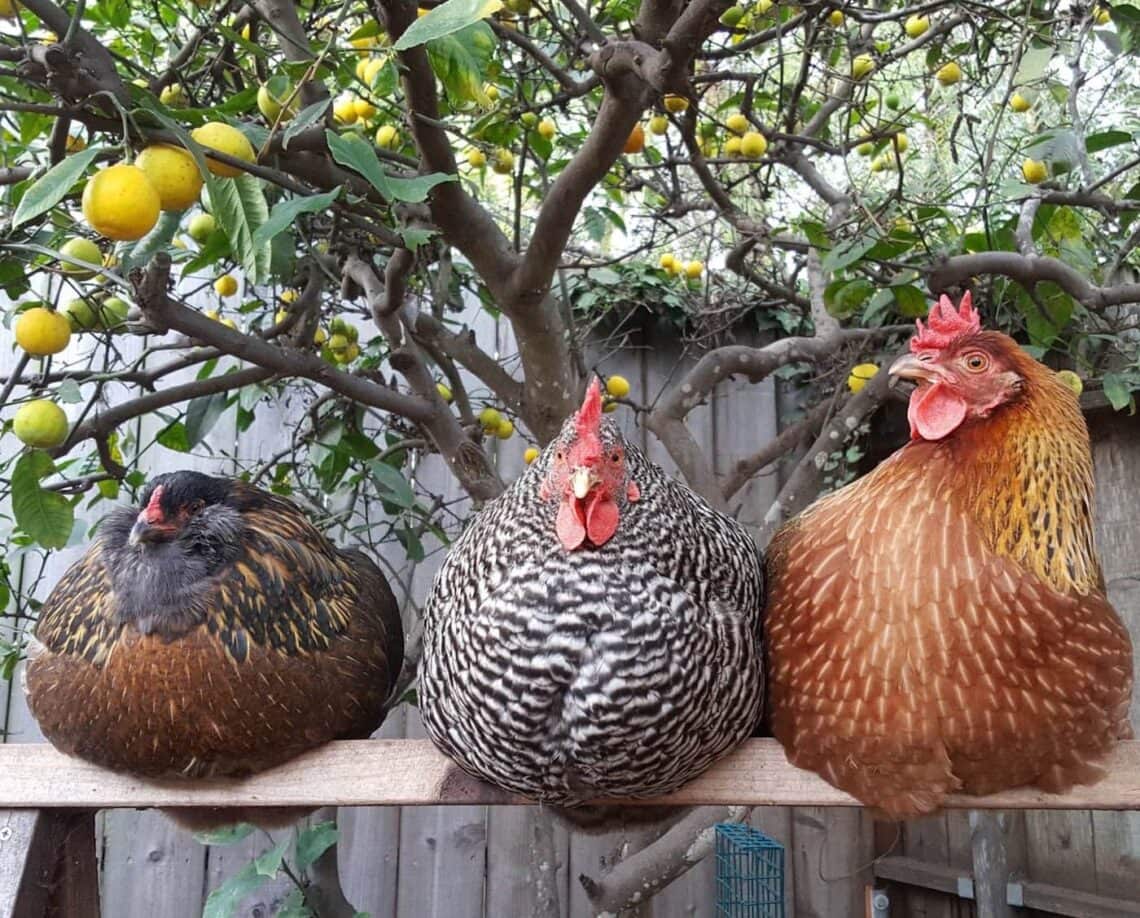
If you’re thinking about getting chickens for the first time, you’re in the right place. This comprehensive beginner’s guide on raising backyard chickens will cover everything you need to know to feel confident and prepared to give them a happy, safe, and healthy home. In return, they’ll provide you with the most delicious and nutritious fresh eggs ever!
This article will explore how to care for chickens, where to get chicks (or older chickens), the best backyard chicken breeds, coop and run essentials, size requirements, predator-proofing, free range considerations, egg laying basics, manure management, food, water, health concerns, and more. This is the ultimate guide on what to expect when you’re egg-specting.
We’ve been raising chickens for over 10 years – including in an average suburban backyard and now on a larger rural property – so we have tips that cover it all. Our girls bring SO much joy to our lives, and I can’t wait for you to experience that too!
NOTE: This article was originally published in February 2019.
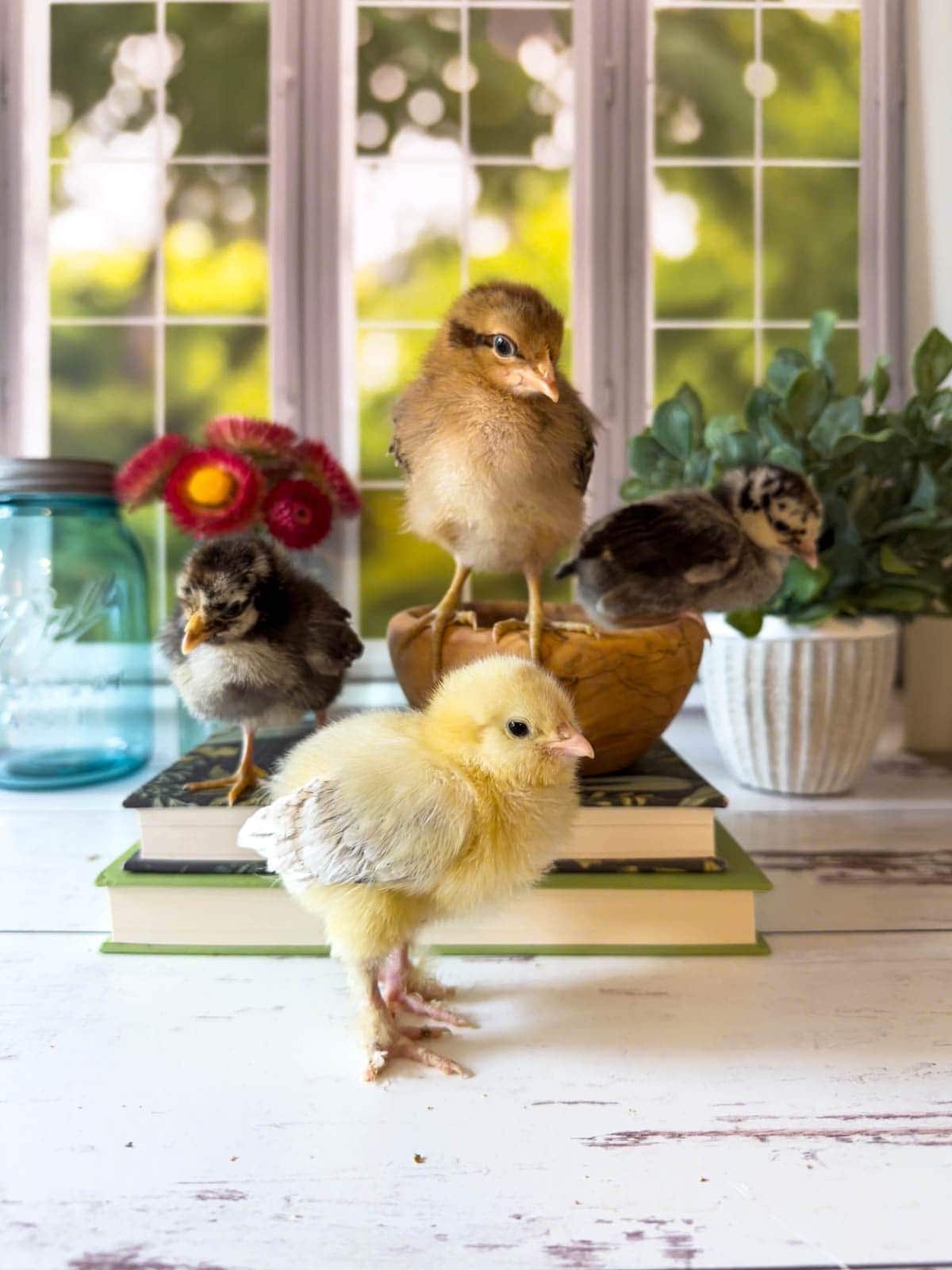
Would you like to save this?
Disclosure: Homestead and Chill is reader-supported. When you purchase through links on our site, we may earn an affiliate commission.
Benefits of Raising Backyard Chickens
Backyard chickens offer endless entertainment, along with the most delicious and nutritious fresh eggs you can get! They are friendly, inquisitive, intelligent, and fairly low-maintenance animals. New chicken keepers are often pleasantly surprised at just how much personality and sass they have. Plus, the feeling of being followed around by an adorable waddling flock or cuddles from your favorite lap chicken is pretty hard to beat!
Chickens can also help to control pest insect populations, and sustainably dispose of some of your garden or kitchen leftovers (though chicken-safe treats should only be offered in moderation). In return, they’ll provide a steady supply of rich manure that (once properly aged and composted) can be used as free fertilizer.
Like any other pet, chickens do require some preparation, responsibility and ongoing upkeep. Once you have everything set up, it’s fairly inexpensive to raise chickens too. 90% of the cost is upfront, while the main ongoing cost is feed.
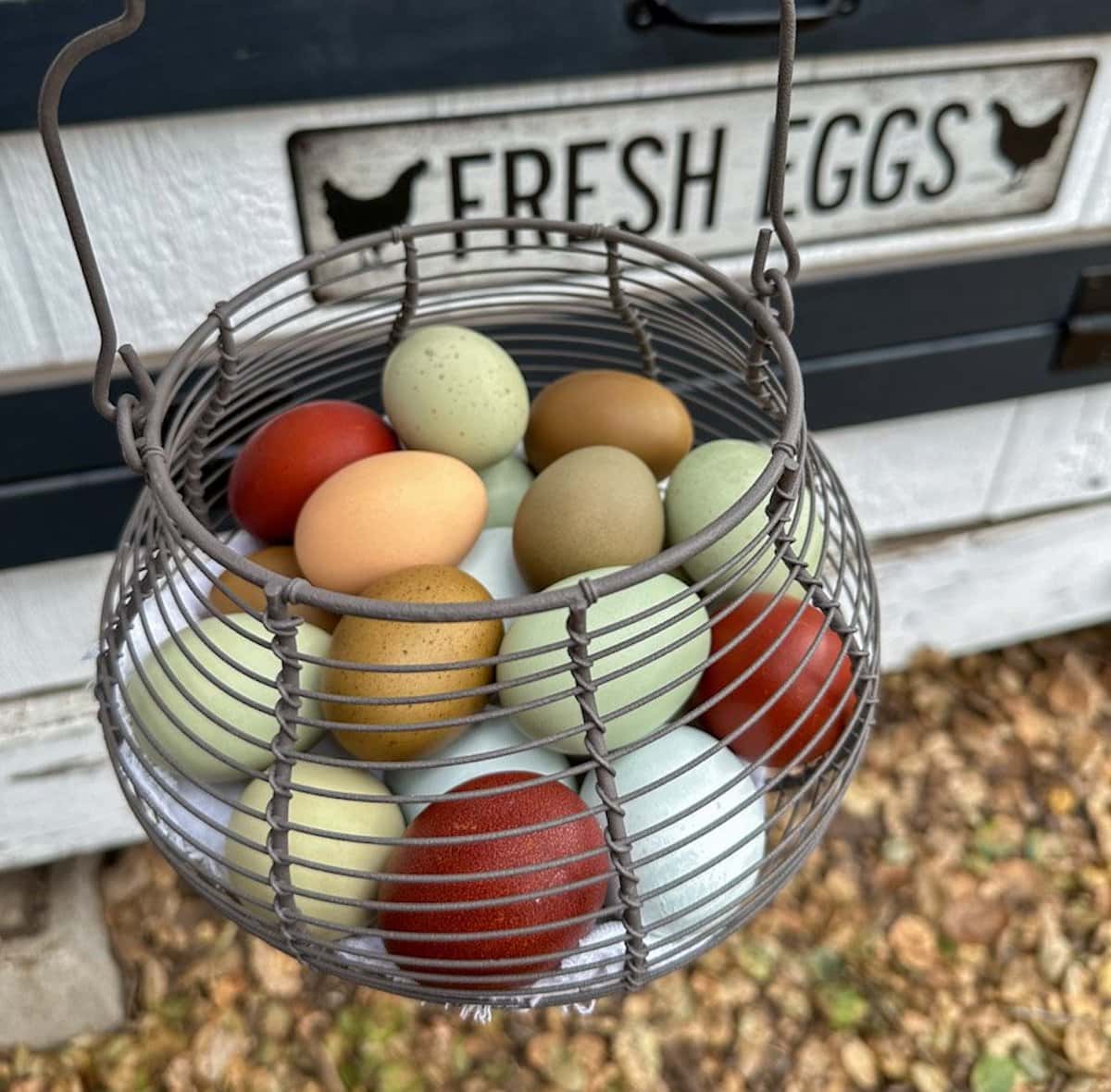
15 Essential Things to Consider Before Getting Backyard Chickens
1) Check Local Ordinances
Before getting chickens, be sure to check local ordinances and regulations. Many towns and HOAs have rules against raising backyard chickens. Some may outright prohibit it, or if allowed, include restrictions for property line setbacks or a maximum number of birds.
For example, the town we used to live in allowed up to 14 chickens, but no roosters, and all of their confined habitat (run and coop) had to be at least 15 feet from any neighboring structures.
Sometimes it can be tough to find the right documents that spell out the rules. Ours is under the public welfare section of the City Municipal Code. Try Googling “(your town/city) poultry ordinance” to find it.
Side note: I always find it little funny when rules allow hens but not roosters, because be forewarned: laying hens can be just as noisy (if not louder) than roosters! Particularly when they’re singing their “egg song”.
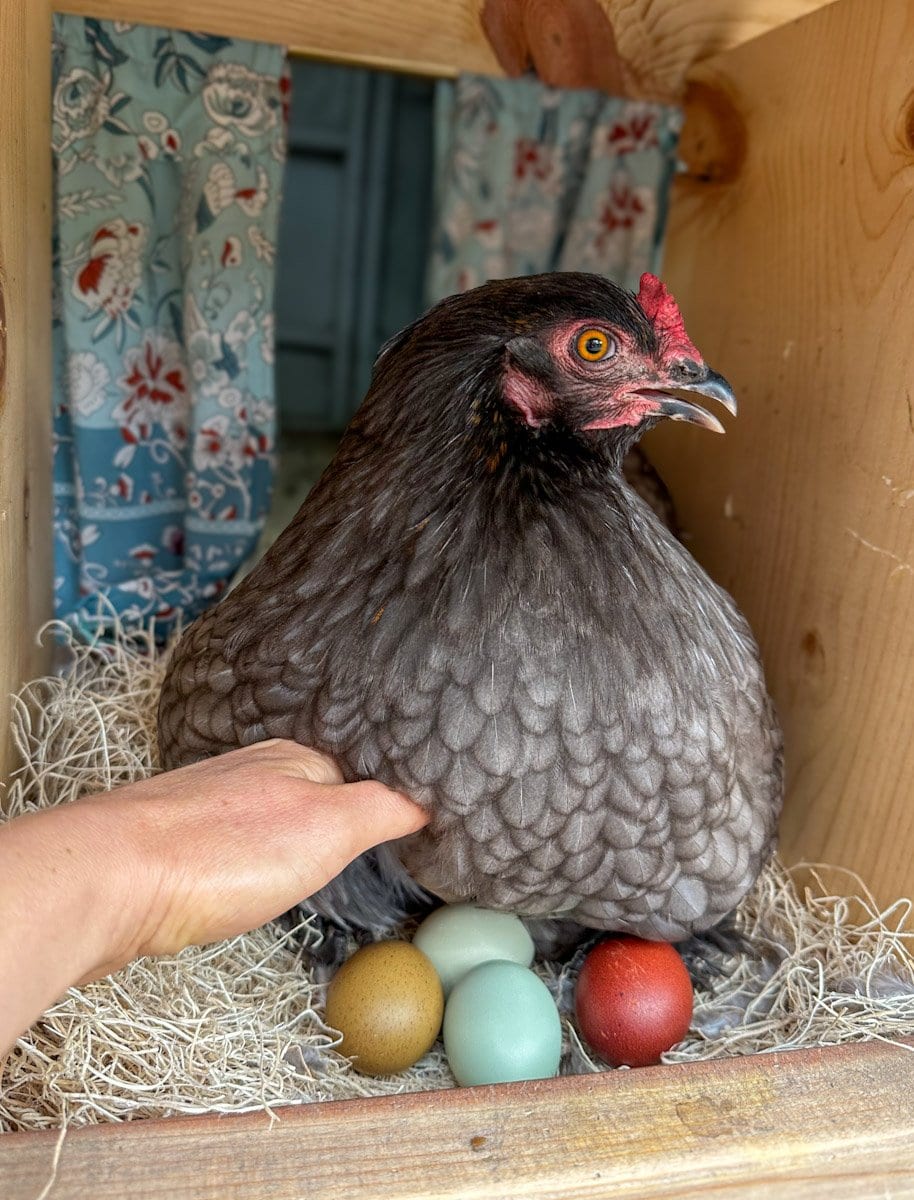
2) How Many Chickens Should I Get?
Chickens are flock animals by nature. They’re social creatures that need at least a few friends around to feel happy and secure. For the average flock and family, I personally think four or five is a perfect starting number. That will give you plenty of eggs, entertainment, and room to expand the flock once you’re comfortable and ready.
If you’re tight on space, three is okay too, but starting with only two chickens is NOT advisable. If something happens to one of them, the last girl standing will be really lonely and you’ll need to find her a friend ASAP. Or, potentially consider responsibly re-homing her.
The size of your coop, run, and yard space will also dictate how many backyard chickens you should have, since the last thing we want is too many hens in the henhouse! Overly crowded or bored chickens may excessively peck at each other (to the point of injury), develop bad feather-plucking or egg-eating habits, and generally be less happy, healthy and sanitary.
See more info about recommended coop and run size minimums in the relevant section below.

3) Best Backyard Chicken Breeds
One of the hardest parts of raising chickens is narrowing down what breeds to get. After all, there are so many wonderful, beautiful chicken breeds to choose from. Not to mention the egg color options! (That’s why “chicken math” happens, lol.)
Some of the most popular backyard chicken breeds for both eggs and a friendly demeanor include Buff Orpingtons, Barred Rocks, Easter Eggers, Cream Legbars, Marans, and Wyandottes. Polish and Silkies are also very sweet, cute, and popular, but not as great for egg production. Their unique feathers can make them higher-maintenance too. It’s also important to consider the breed’s heat or cold tolerance for your area.
LEARN MORE: See our complete list of the 18 best backyard chicken breeds for photos, demeanor, heat or cold hardiness, egg color and laying frequency of each one. Also don’t miss this list of over 500 of the best cute and funny chicken names!
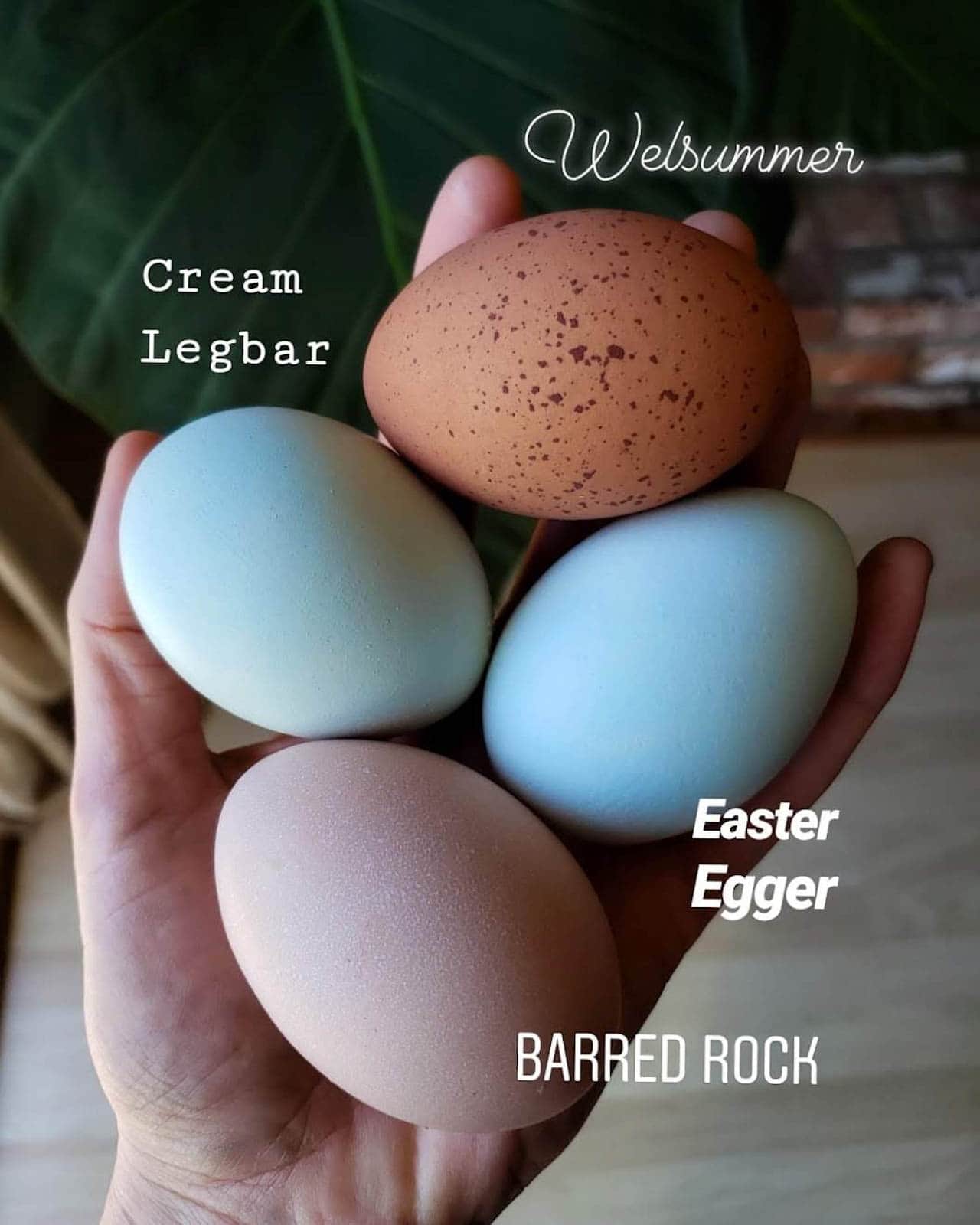

4) Starting with Chicks, Pullets or Eggs
There are a number of ways to get started with backyard chickens, including raising them from chicks, adopting young “coop-ready” pullets or already-laying hens, or even getting eggs to hatch yourself. Getting day-old chicks is the most common route, and what we always like to do!
Chicks are available either as sexed “guaranteed females” (though mistakes can happen) or unsexed “straight run” chicks – a 50/50 chance of being male or female. Folks brand new to raising backyard chickens usually avoid roosters at first due to the noise, potential agression, different flock dynamic, and added learning curve.
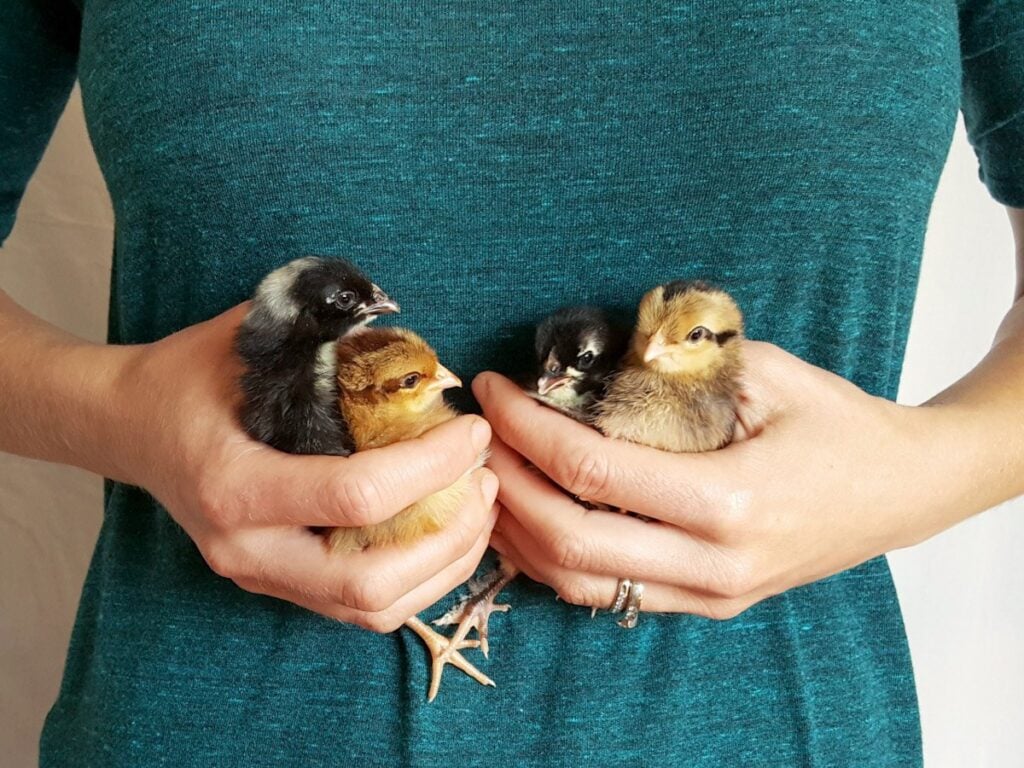
Raising Chicks
Starting with day-old chicks will give you the best opportunity to form a strong bond with your chickens. It also exponentially increases the chances they’ll be easier to handle (important for health care!) or even want to cuddle with you. Not to mention the cute factor. If you have kids, they’ll be SO excited to have fluffy baby chicks around!
However, raising chicks is a big commitment! You become their mama, and must be prepared to tend to their needs and provide them a safe warm space (indoors, in a garage, or other protected location) for at least 6 to 8 weeks before they can fully live outdoors without supplemental heat.
Before bringing chicks home, have a brooder (protected enclosure) and related equipment ready and waiting. See how to set up a chick brooder here including a week-by-week brooder temperature chart. The brooder will need a daily clean-up, along with frequent food and water changing, to keep them happy and healthy.
LEARN MORE: Please visit our comprehensive beginner’s guide on raising baby chicks for more details. Also don’t miss these 11 easy DIY chick brooder box ideas.

Hatching Eggs
If hatching your own eggs at home sounds interesting, check out this detailed guide. However, I feel this might be an overwhelming option for someone brand new to raising chickens. We haven’t incubated eggs at home (yet) ourselves.
Some of the benefits of hatching eggs include: no stress for the birds during shipping, a large selection of breeds to choose from, and a fun learning experience for the kiddos, and you!
The possible drawbacks are: potential to deal with rare complications, deformities, or even deaths during incubation or hatching. There is also no control over the sex of the birds, plus the additional equipment, time, and knowledge needed.
Adopting Pullets
If fussing over a brooder and having tiny pooping creatures in your house doesn’t sound like your cup of tea, you may want to consider getting slightly older chicks, called pullets.
Pullets are female chickens that are approximately 8 to 28 weeks old. They’re fully-feathered and “coop ready” (so no need for a brooder). You can tell their sex 95% of the time by now, but they haven’t yet started laying eggs. And, there is still a great chance of forming a close bond with them if you put in some dedicated hang out and treat time!
Laying Hens
If you want fresh eggs right away, and having a super strong bond with your backyard chickens isn’t all that important to you, then getting young laying hens may be the way to go!
It’s best to get a handful of birds that were already together if possible, since introducing new chickens to each other can be tricky – including a quarantine process and gradual (supervised) introduction process. The pecking order can be brutal! Especially with adult birds from different flocks, or when introducing chicks to adults. Chick-to-chick is a little easier.
Learn best practices about how to introduce new chickens to a flock here.

5) Where to Buy Chicks or Chickens
You can buy baby chicks, chickens, or hatching eggs from large commercial hatcheries, local feed stores, a local farm or breeder, that random person on Facebook, and more. There are pros and cons to every option, explored in more depth in this post on where to buy chicks.
As odd as it may seem, it’s a common practice to ship live chicks in the mail. Upon hatching, chicks absorb their yolk sac, which gives them enough nutrients to survive those first few days without food or water. They’re shipped with heat packs to keep them warm, though I’m sure the journey is a bit stressful regardless.
You’re most likely to get all female chicks (though never 100% guaranteed) when ordering through a large hatchery or feed store; they usually cull the males. Big hatcheries also offer the largest selection of breeds. On the other hand, it’s always great to support smaller or local operations who likely treat the animals far better too!
Use caution when adopting chicks or older chickens from Facebook or similar outlets; who knows what their biosecurity practices are! Always be sure to quarantine new birds and follow best practices for introducing new chickens.
We’ve bought chicks from a mix of places over the years: some from commercial hatcheries, some from our local Tractor Supply (which source chicks from a local hatchery). We ordered our last batch of chicks from Alchemist Farm, a small CA-based humane and sustainable hatchery.
RELATED: Not sure who’s who? Learn 5 ways to tell if a baby chick is male or female.
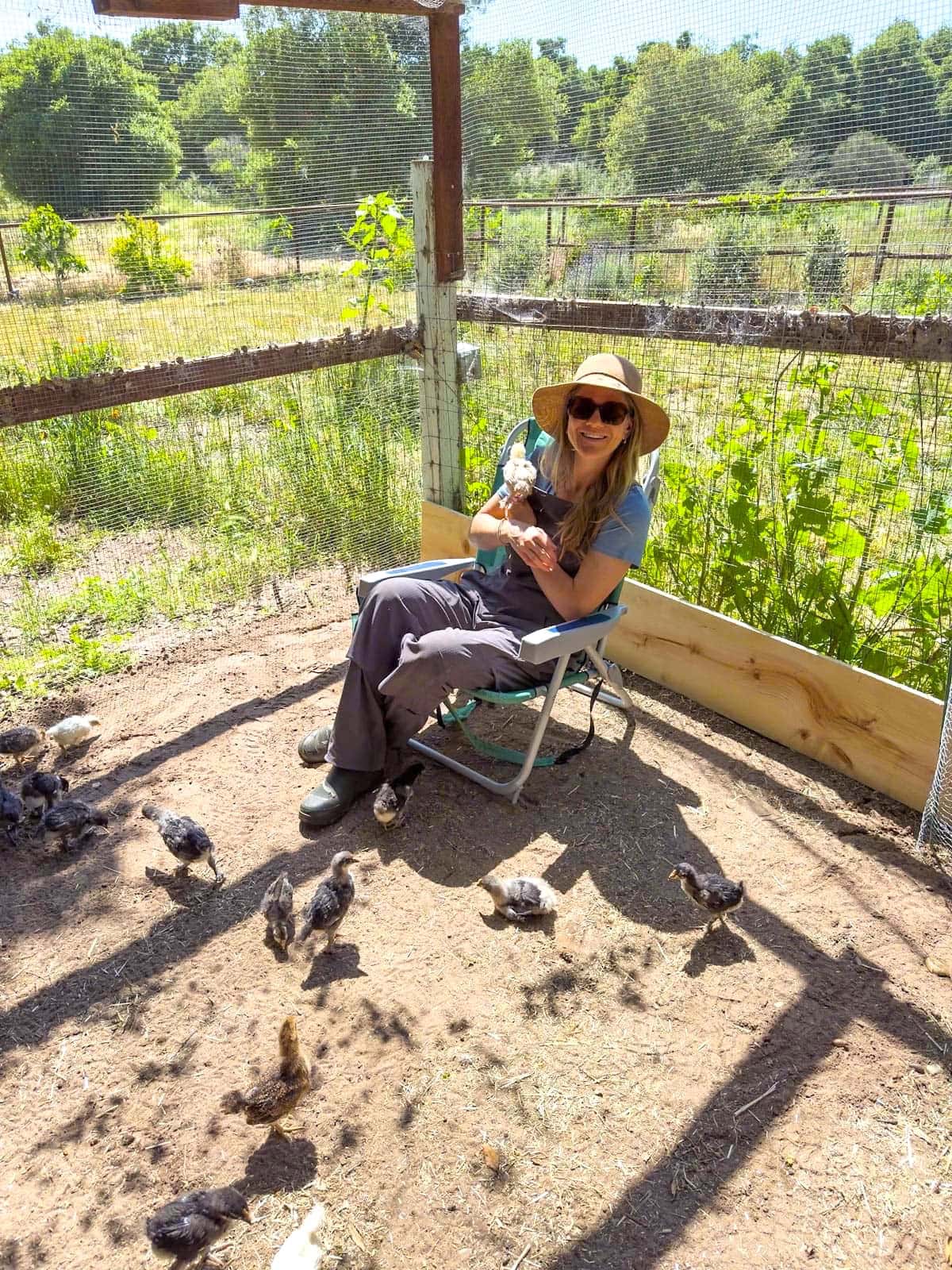
6) Chicken Coop and Run Essentials
One of the most important and impactful things you’ll ever do for your future beloved backyard chickens is to provide them a safe, secure (read: predator-poof) and comfortable home.
Chicken coops come in all sorts of shapes, sizes, and styles, including larger walk-in style coops or smaller reach-in ones. In addition to considering your flocks needs, don’t forget to account for yours! You will be the one who needs to regularly access the coop for cleaning, collecting eggs, and other chores.
Adjacent to the coop, your chickens will also need a protected run: a large enclosed space where they’ll spend most of their time outdoors. Even if you plan to let your chickens mostly free range, it’s best to also have an adequately-sized run in place too.
Let’s explore coop and run size requirements and other essential below.
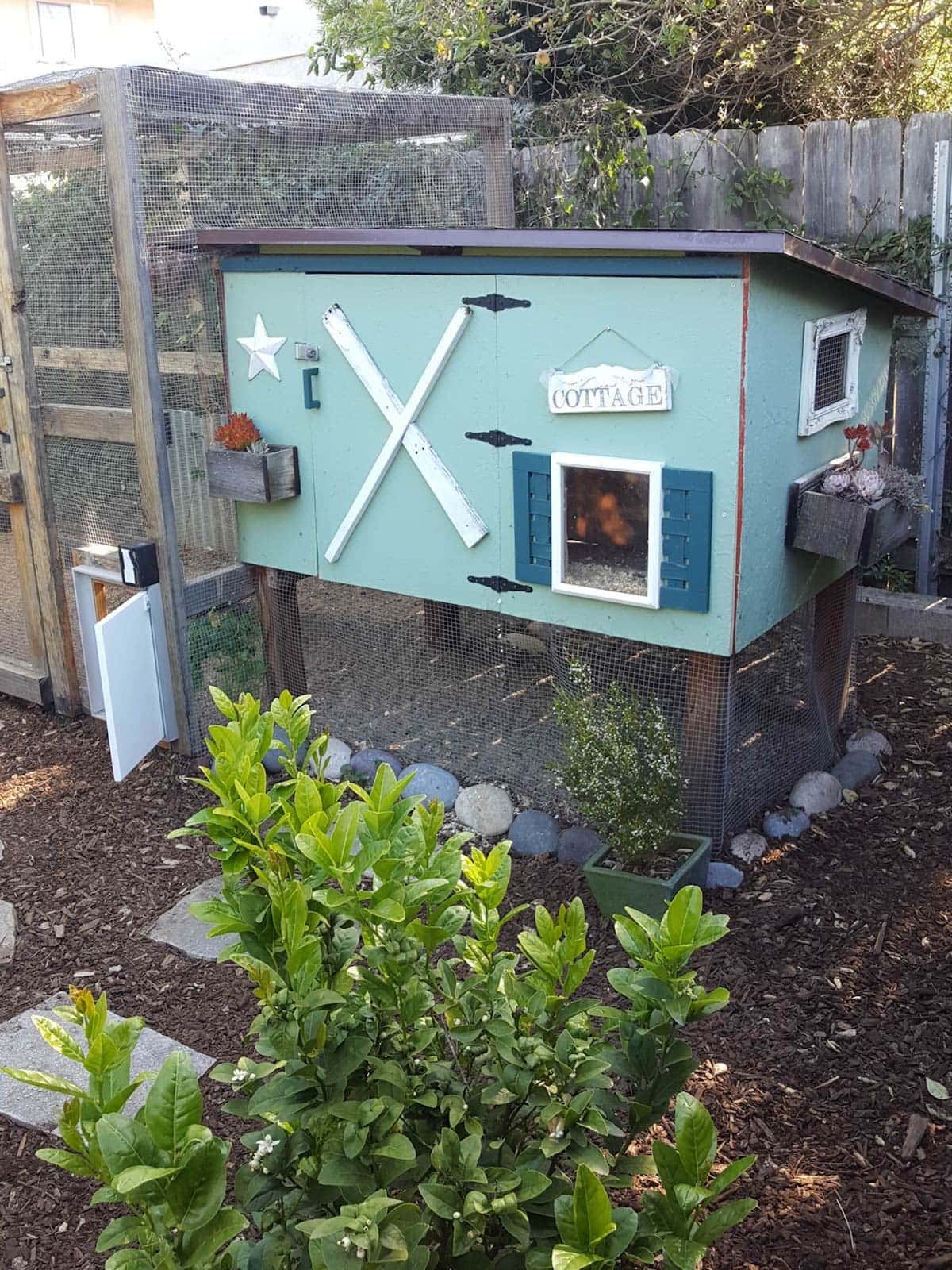
Where to Put a Chicken Coop
Ideally, a chicken coop and run should have a good mix of sun and shade. If you don’t have natural shade available, you can create a shaded area using a shade canopy, add a roof over a portion of their run, or other cover.
If you can also incorporate mature trees in or around your chicken run, they’ll thank you endlessly! Our girls love to hang out under the canopy of trees and shrubs all day. They feel most secure under cover, and also rely on shade to help stay cool during hot weather. Yet chickens prefer sunny spots for dust bathing, along with stretching out in the sun on cool days to warm up. Ample sunlight is also key for good egg production!
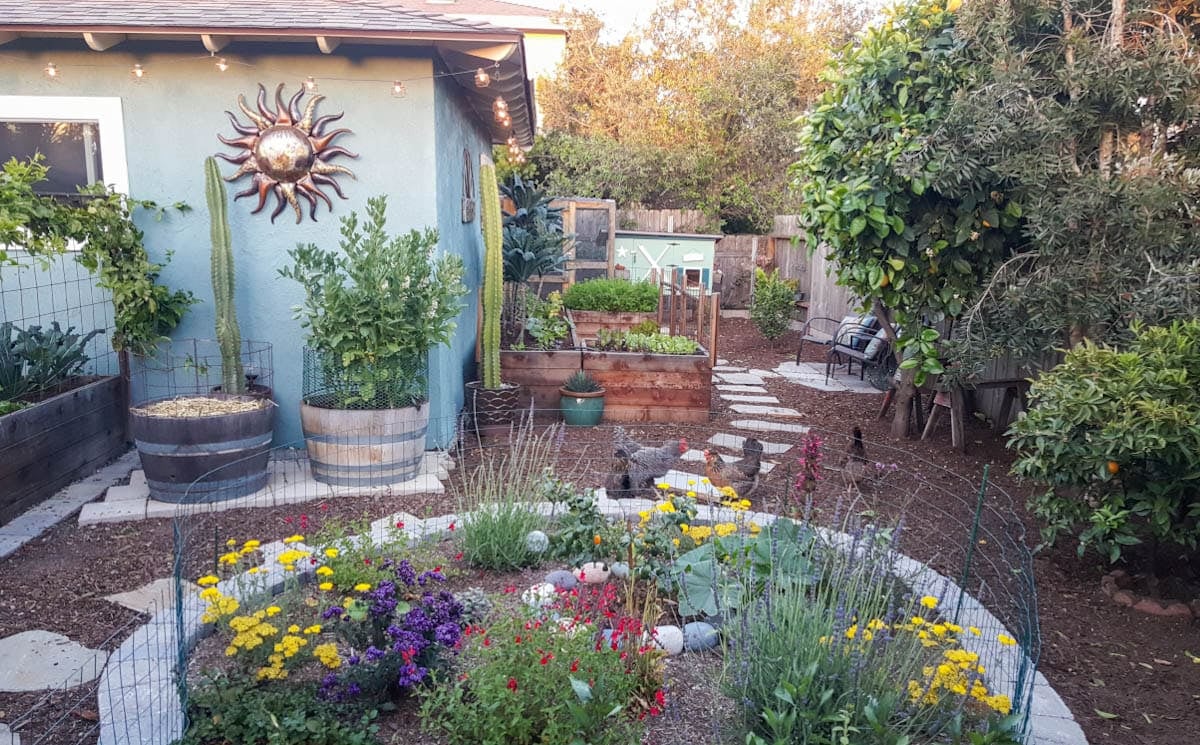
Chick Coop and Run Size Minimums
The recommended minimum size for a chicken coop is 3 to 4 square feet per chicken, and about 10 square feet per chicken for their enclosed run space. Bigger is better, if possible!
Since we have very mild winters here, our girls only use their coop to sleep and lay eggs. Yet if you have long harsh winters, plan to have a coop that’s large enough for extended stays with room for food, water, and other necessities inside. A coop that you can walk in to may be preferred in that situation.
PRO TIP: Avoid minimum coop and run sizes so you can eventually expand your flock, because you inevitably will want to! It’s called chicken math, and it’s a very real thing.
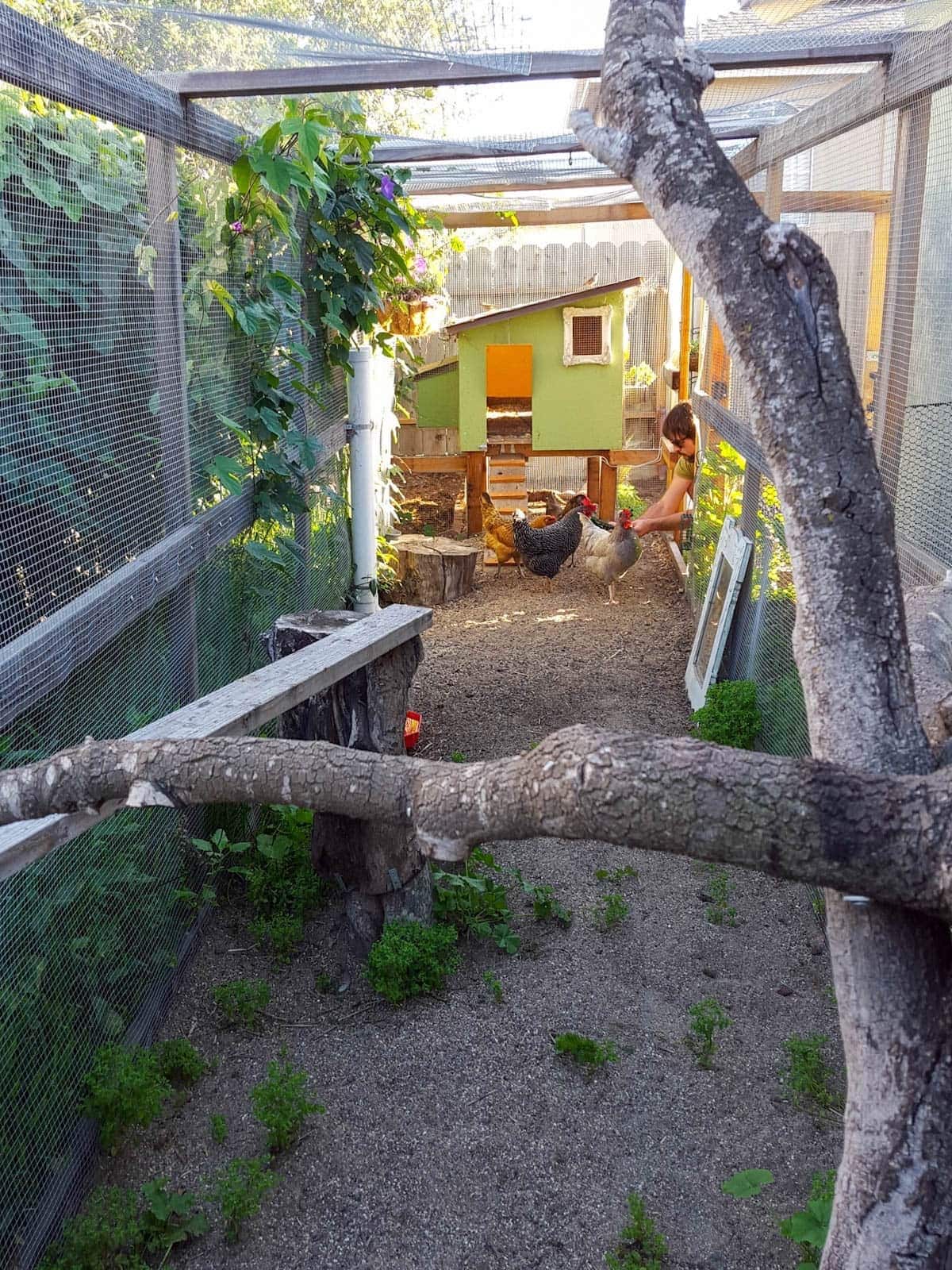
DIY Chicken Coops
It’s fun to design and build your own DIY chicken coop, customized to your exact space and needs. Our first coop was a smaller reach-in coop that we built using mostly recycled materials, with a large access door for easy cleaning at waist-height. I recommend elevating small reach-in coops so you don’t have to bend down. The chickens prefer the added height too!
Our current coop is a larger walk-in style, converted from an old shed. It’s pretty easy to turn a shed into a chicken coop! Just add roosts, nesting boxes, a chicken-size door, and secure vents or windows as needed.
Here is a collection of 46 buildable chicken coop plans.
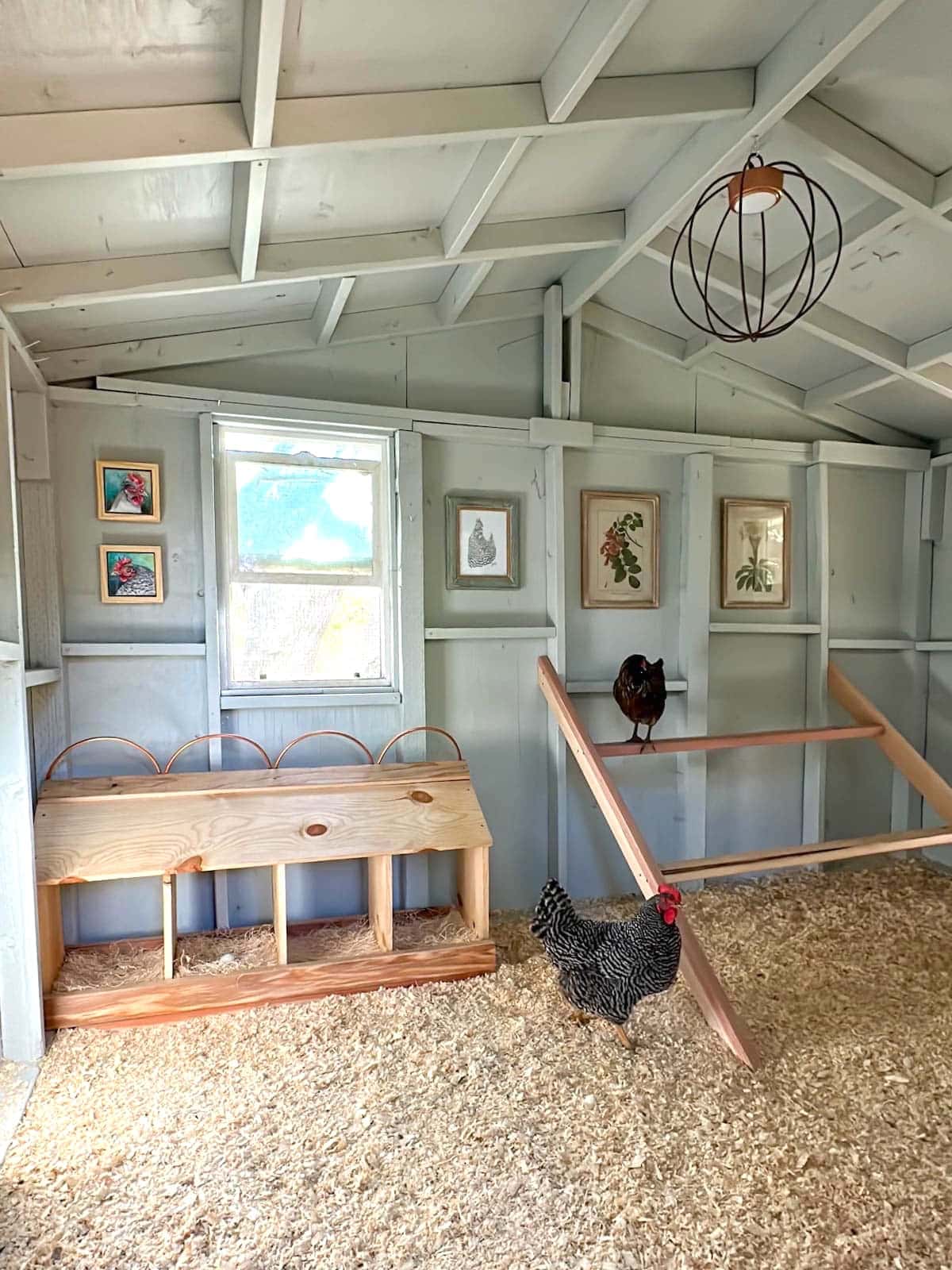
Pre-Made Chicken Coops
If you’re not up for building your own, there are plenty of pre-made chicken coops available to buy. I’ve seen some really nice ones out there, including custom-built ones from local companies or Carolina Coops (no affiliation).
You’ll also see little pre-made coops at Costco or Farm Supply that cheerily claim are “designed for up to four chickens!” – but proceed with caution. They are often quite small, designed for sleeping and egg laying only (not food, water, and extended stays during inclement weather). They may also be tricky to access for cleaning. The miniature “runs” that come connected to those coops also tend to be grossly undersized, so plan to add additional run space.
The number one regret I hear from people raising backyard chickens is that they wish they’d built their own coop or bought something bigger. That, or wishing they’d better predator-proofed their coop and run… which we’ll discuss shortly.
What’s Needed Inside a Chicken Coop or Run
Here is a list of key items that should be inside a chicken coop or run. Here is a complete list of our favorite chicken supplies too.
- Roosts to sleep on, with about 10 to 12 inches of roost space per chicken. Roosts can be located anywhere from 6 to 8 inches off the bottom of a small coop, or several feet high in a taller coop. However, chickens will always sleep as high as possible, so roosts should be located higher than (but not directly over) nest boxes so they’ll sleep and poop in the correct spot. A flat roost (such as a 2×4″ on it’s wide side) is more comfortable than round dowels, and can also help prevent frostbite or bumblefoot. Keep roosts 12″ away from the wall or other roosts to prevent a poopy mess.
- Nest boxes are a cozy designated place to lay eggs, which offer privacy and keep eggs clean. As a general rule of thumb, provide at least one 12×12″ nest box for every 3 to 4 chickens. We’ve had two nest boxes for four chickens, and currently have four nest boxes for 13. We like to use these nest box liners to pad the bottom (and prevent broken eggs).
- Food, water and free choice calcium (usually in the run, except may in freezing conditions) discussed in following sections.
- Windows and/or ventilation, necessary to keep the coop cool during hot conditions, release warm steamy air during the winter, and circulate fresh air to reduce dust and odors. All vents should be up high and covered with hardware cloth. Avoid drafts during winter.
- Litter or flooring material. Inside the coop, we like to use absorbent hemp bedding and/or pine shavings paired with a vinyl covered “poop board” below their roost for easy daily cleaning. Washed concrete sand or sandy soil is a popular choice for chicken run flooring. We also like shredded redwood mulch or wood chips in the yard, but avoid cedar. It’s toxic to chickens.
- A dust bath area, which they use to clean themselves. Learn more about chicken dust baths here.
- Other boredom busters and entertainment like natural roosts, log piles, straw bales, swings, or a chicken grazing box. Sawhorses make great roosts too!
- Highly recommended: an automatic coop door to make sure they’re safely locked into the coop each night, even if you forget or aren’t home.



Climate and Weatherproofing
Your chicken coop and run should be equipped to handle whatever type of weather is common in your area. At least a portion of the run should have a waterproof cover to offer the chickens shelter and keep their food dry on rainy days. For example, the section of our run closest to the coop has clear sheets of corrugated roofing material over it. The floor material in the run should be well-draining to avoid a muddy mess during rain too.
There are a number of easy ways to winterize a chicken coop, such as by wrapping the run with clear durable plastic or adding extra insulation inside the coop (e.g. deep straw bedding). On hot summer days, offering cool treats, a fan in the coop, or misters outside can be literal lifesavers!
In general, backyard chickens are far more tolerant or hardy to cold conditions than they are to extreme heat, depending on the breed. I have many friends who’ve lost beloved chickens to heat stress!
RELATED: Learn more about how to keep chickens warm during cold winter weather (and prevent frostbite), along with 10 ways to keep chickens cool during hot summer weather or heat waves.
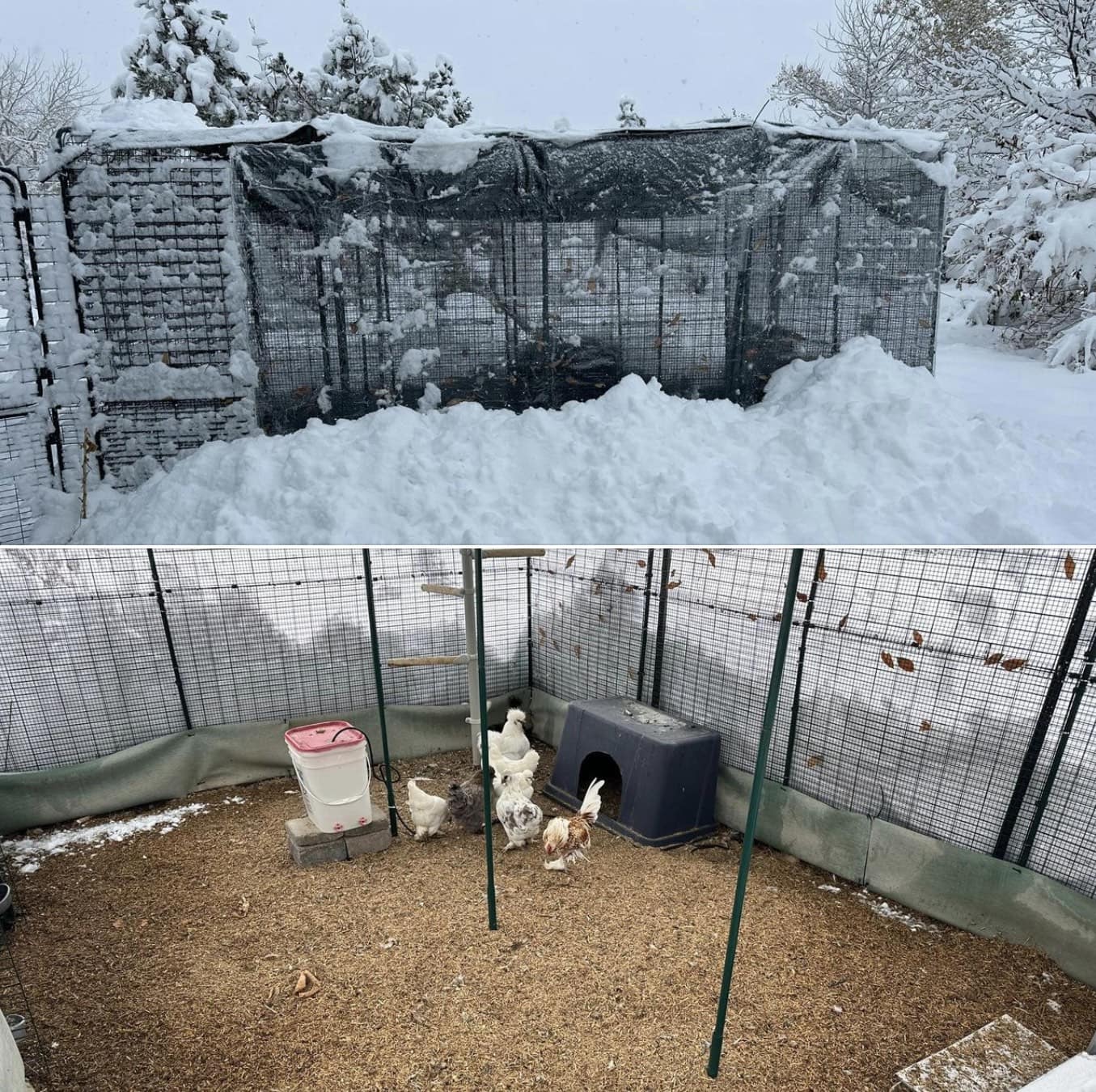
7) Predator Proofing
Backyard chickens are vulnerable to many daytime and nighttime predators. Sometimes it feels like everyone’s out to get these poor dears! Chickens can’t see in the dark and can’t fly all that well, leaving them fairly defenseless. So, properly predator-proofing your chicken coop and run should be taken seriously, including thoughtful design and using the right materials.
Chicken Predators
Predators to chickens include hawks, owls, weasels, foxes, coyotes, raccoons, opossums, bears, bobcats, mountain lions, or other large wild cats. Dogs may be a concern unless they’re properly trained or raised around chickens. Domestic or feral cats are typically not a threat once chickens are fully grown. Snakes may try to eat chicken eggs. When raising baby chicks indoors, make sure to carefully monitor their interaction with your other larger pets.

Hardware Cloth vs Chicken Wire
Don’t let the name fool you! Chicken wire does NOT offer adequate protection for chickens. It deteriorates with time and is pretty flimsy, easily chewed or ripped through by predators. Plus, the large gaps in the wire can allow rodents, snakes, and other pests in.
Rather, the best fencing material to predator-proof a chicken coop and run is galvanized hardware cloth with ¼” openings. To prevent predators from digging under, it’s best to also bury hardware cloth in a 1-foot deep apron around the perimeter of the coop and/or run too.
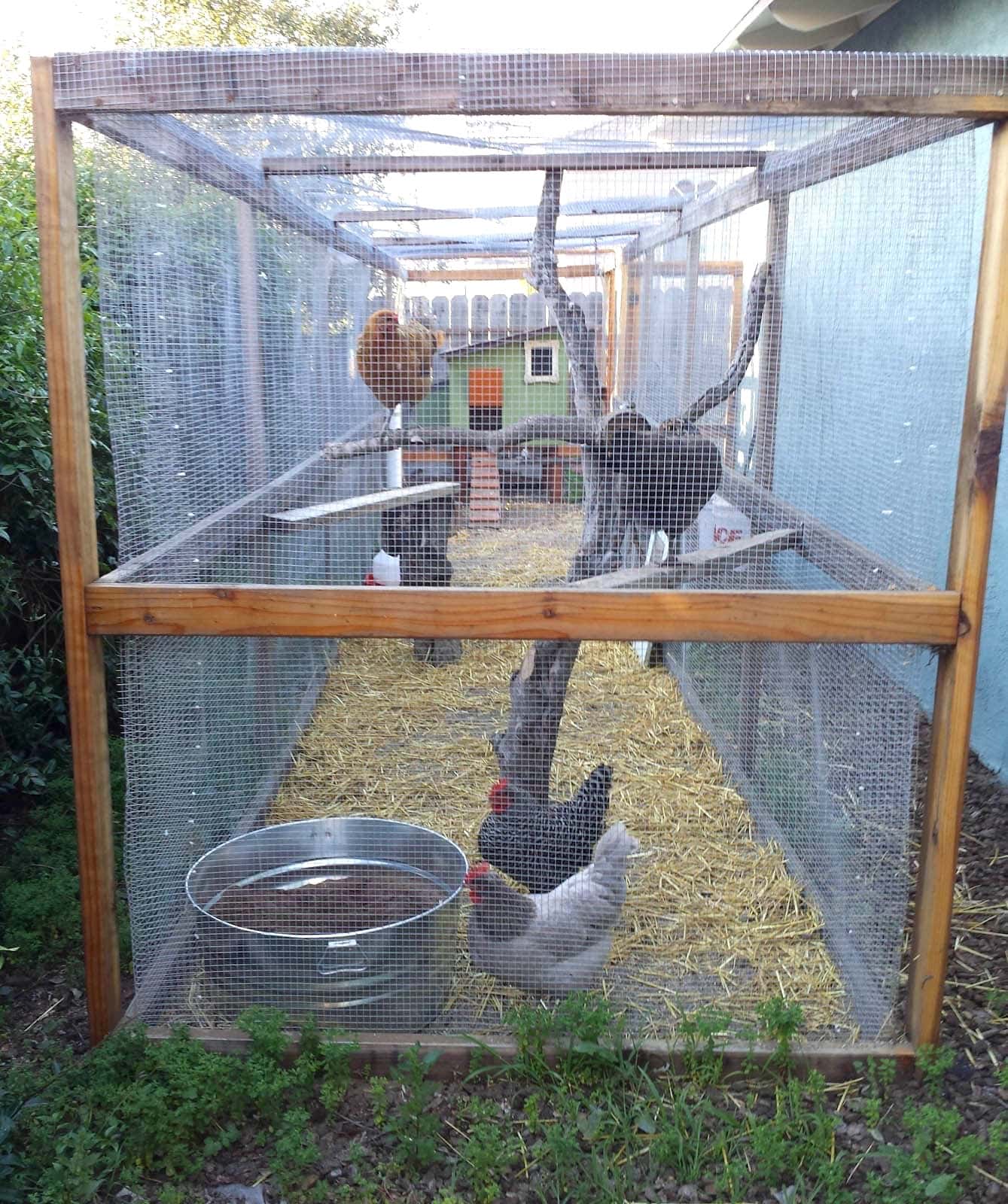
Rodents
Rodents can squeeze through pretty tiny holes (the size of a quarter) so make sure to take that into consideration when looking into coop and fencing options. Mice and rats may not harm your chickens, but they’re a nuisance. You don’t want them in your backyard chickens’ space. They might try to eat eggs, and it is not sanitary to have them around the feed and water.
Predator-proofing a chicken coop and run
The coop should be your chickens ultimate safe haven. It should be completely enclosed and constructed of sturdy materials that can’t be broken into by wild animals. This includes any latches, locks, gaps, doors or windows. Cover all windows and vents securely with hardware cloth.
On the other hand, the level of protection in the chicken run will depend on your situation and predator pressure. For instance, if nighttime predators are the primary concern, and you have a super secure coop that the chickens are safely locked in at night, then a lightly fenced and covered run area may be okay during the day (e.g. using chicken wire, chain link fence, or other fencing materials). But if you have coyotes, bears, bobcats, mountain lions, foxes, etc (or, ever may not be home to put them away before dark) plan for a sturdy run too.
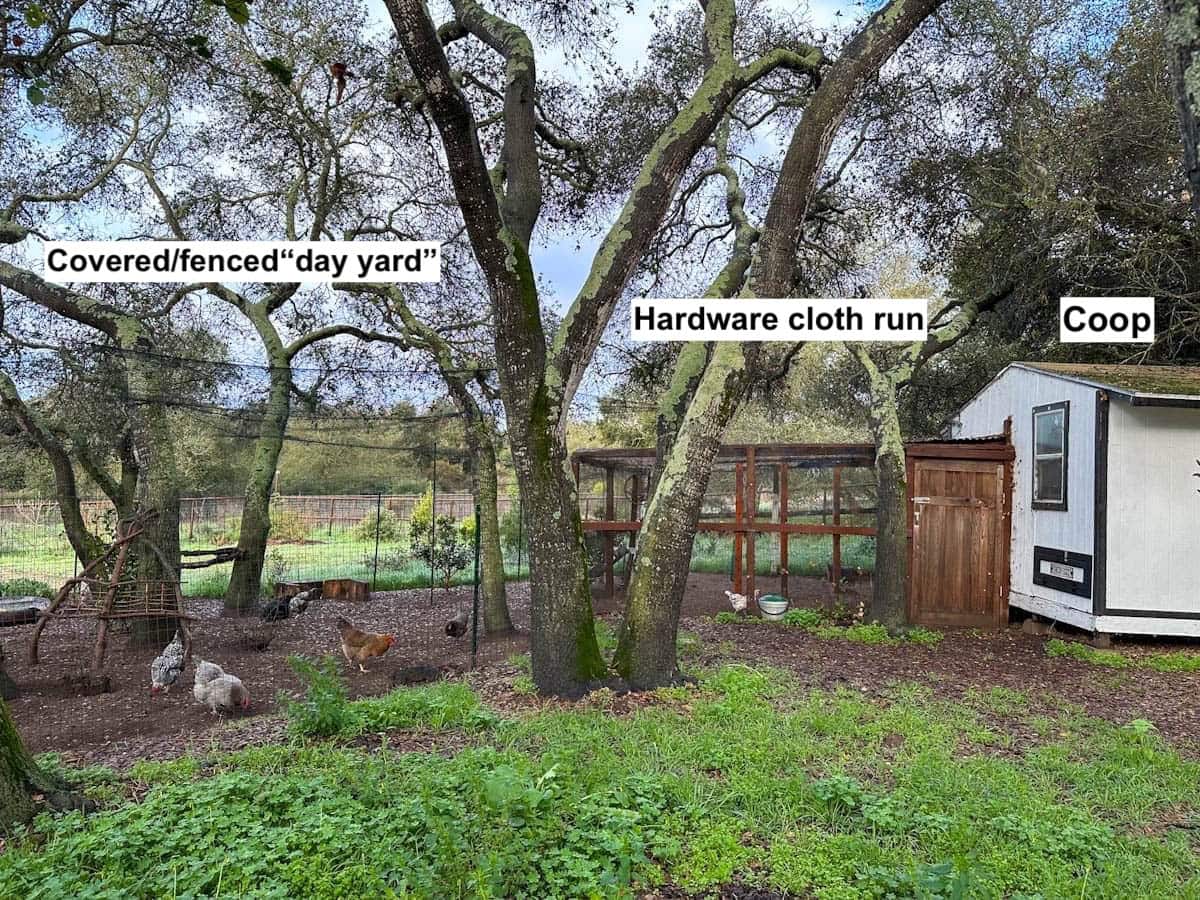
8) Food, Water, and Treats
Chicken Feed
It’s important to feed your chickens age-appropriate feed since baby chicks, pullets, and laying hens all have different nutritional needs. “Starter” and “grower” feeds for younger birds have more protein to support rapid growth. Layer feed has slightly less protein and a little extra calcium. When switching between feeds, it’s best to mix and gradually transition them.
There are a ton of options for chicken food out there, including making your own blend. If you choose to do so, ensure you find a recipe that gives them all the nutrition they need! We prefer to leave that to the pros and feed our chickens organic, non-gmo Scratch and Peck layer feed. We also ferment chicken feed on occasion, for an extra boost of nutrition and probiotics. The quality of their diet gets passed down to us through their eggs, after all!
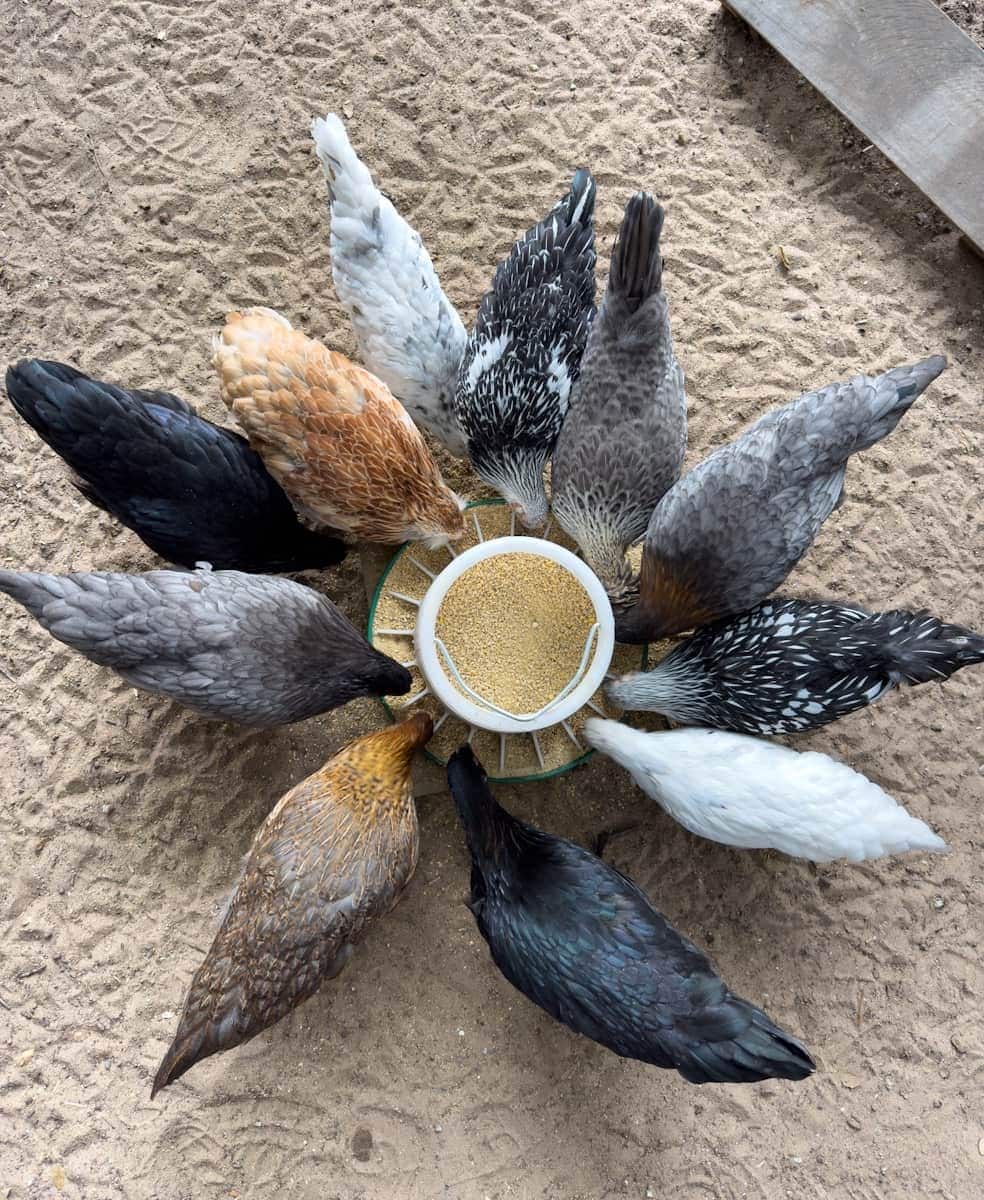
Food Storage and Biosecurity
Most backyard chicken keepers do not put out fresh food every single day. That’s awesome if you do, but that takes a lot of work! Instead, we leave out large feeders to top off or refill as needed. We also fully empty and deep-clean the feeders periodically so nothing gets moldy or stale.
However, it’s important to practice good biosecurity and limit other animals from accessing your chickens food and water as much as possible. Wild animals (including other birds) may carry parasites or diseases that could be transmitted to your backyard chickens. We keep our girls food and water inside their pest-proof run.
Store extra bulk chicken feed in a dry, vermin-proof container. We keep all of our chicken food, treats, and miscellaneous supplies in our garage where rodents aren’t an issue. If you keep chicken feed outside or in a shed with minimal wildlife activity, consider a heavy-duty, BPA-free, plastic container like this one. If you need a little more protection, you could use a galvanized metal container like this one. They’re both made in the USA!
Water
Fresh, clean water needs to be available at all times. Like their feed, it should not be accessible to wild animals (to the best extent possible). In addition to topping off their water as needed, be sure to fully empty and clean their waterers as often as needed to prevent mold or algae growth.
In our many years raising backyard chickens, we’ve tried several types of waterers and this one is our current favorite. It never grows algae like our other ones did! Poultry nipples are another popular choice to keep water extra clean, but our flocks never took to them.
Calcium
Once your chickens start laying eggs (or just before), you’ll also need to put out a free-choice calcium source such as crushed oyster shells or egg shells. It should always be available and separate from their food. This is essential to support healthy eggshell development and prevent serious health issues like egg-binding!
Learn more and how we prepare baked crushed eggshells or oyster shells for our chickens here.
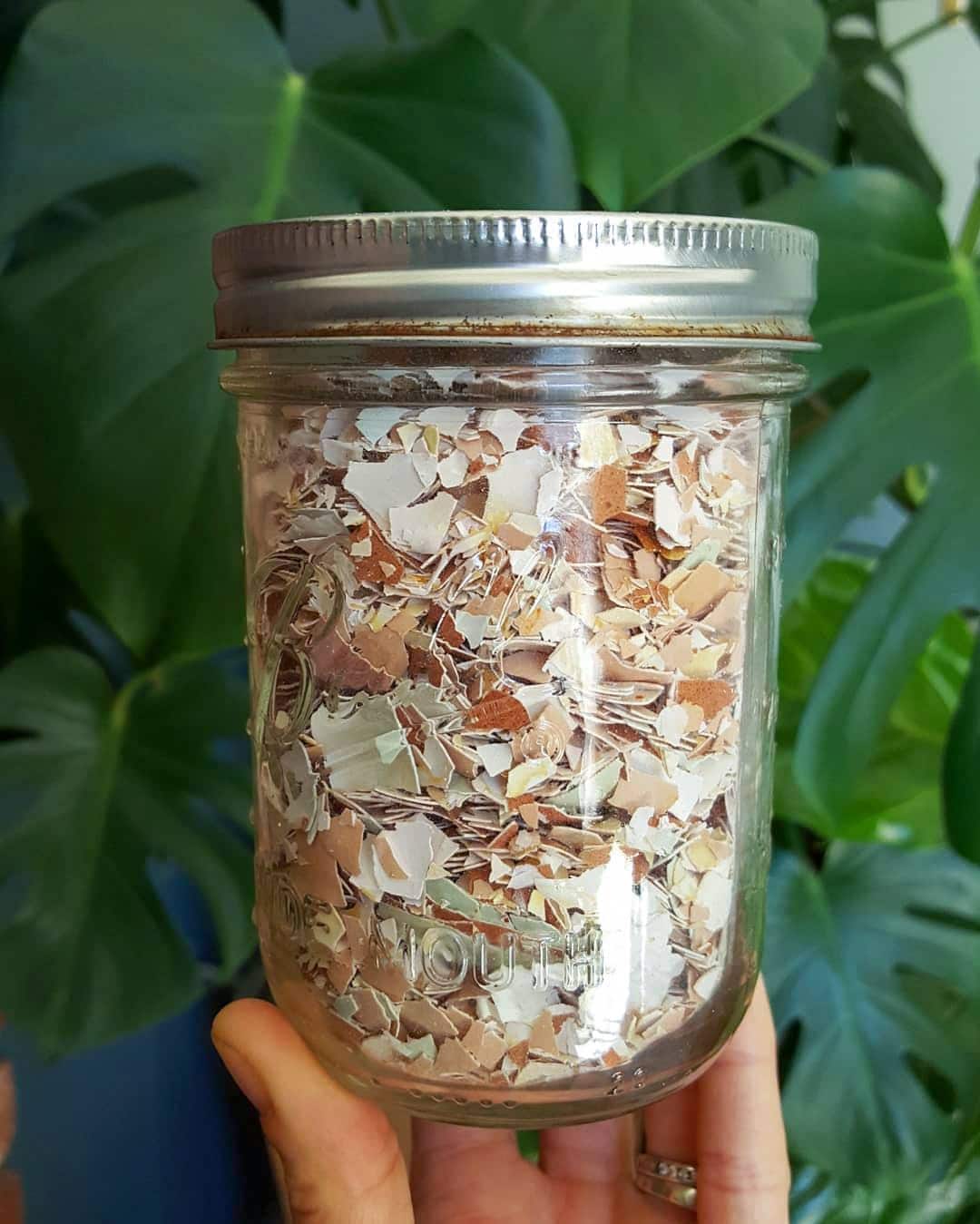
Treats
A backyard chickens diet should primarily consist of layer feed, and whatever plants and insects they pick at while free ranging. As tempting as it may be, don’t treat them like your living compost system – tossing every scrap of kitchen and garden waste their way. This can throw off their nutritional balance and cause health issues, so only give treats in moderation.
Safe chicken treats include dried mealworms or grubs, black oil sunflower seeds, scrambled eggs, flock block, chicken scratch, and most fruits and vegetables. Our girls especially love getting kale, lettuce, and other leafy greens from our garden!
Do NOT feed chickens: dried beans, leaves or unripe fruit from the nightshade plant family (tomatoes, peppers, eggplant, potatoes), citrus, junk food or processed food, moldy or rotten food, apple seeds, avocado peels or pits, chocolate and candy.
RELATED: Visit our complete guide on what chickens can eat (or can’t eat) to learn more, including safe treat ideas and toxic foods or plants to avoid. Also don’t miss our homemade flock block recipe!
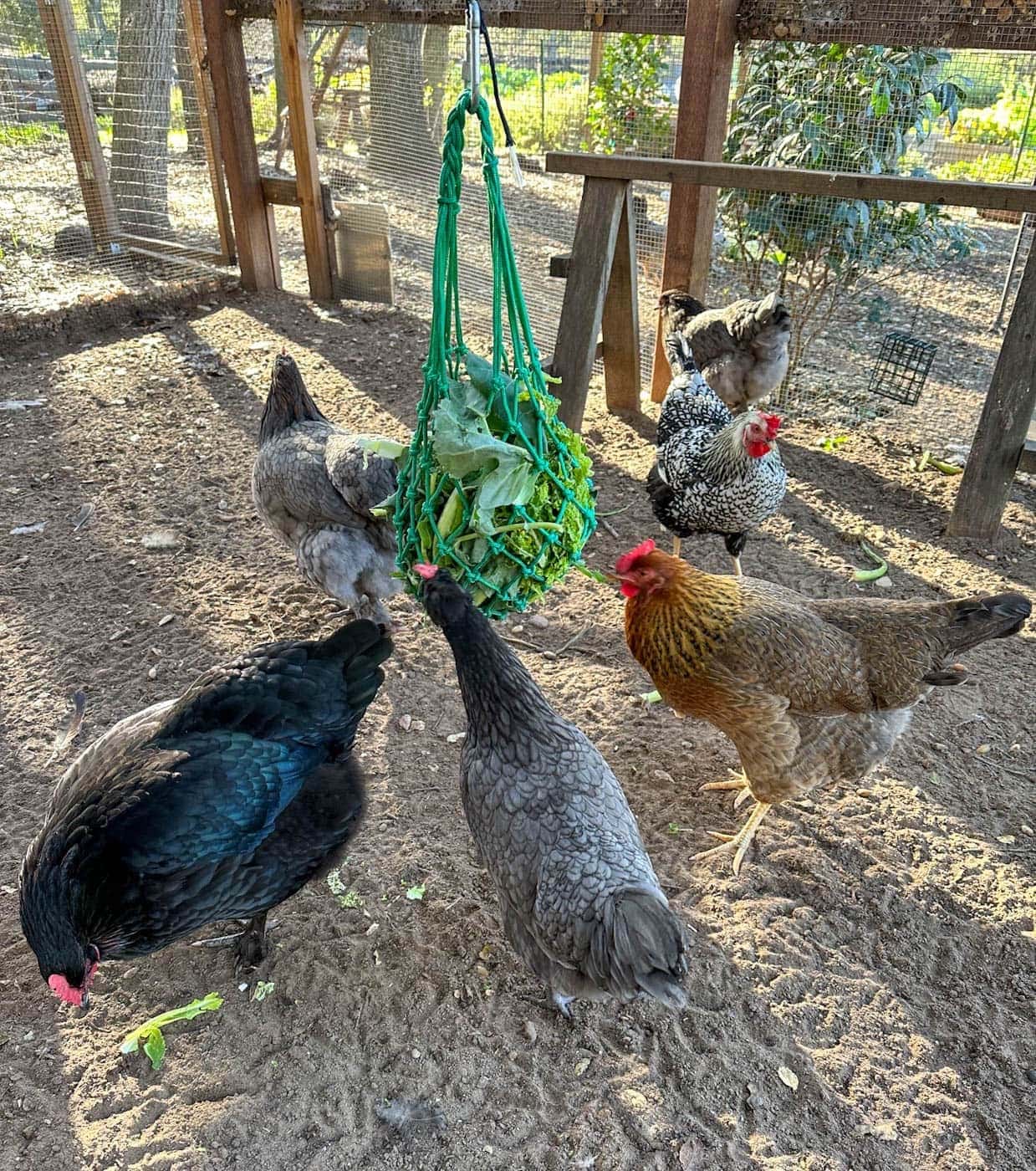
9) Nest Boxes and Egg Laying
This is one of the best parts of raising backyard chickens, right? The most fresh, ethical, delicious and nutritious eggs possible – straight from your backyard. They really can’t be beat! For us, our chickens are beloved pets first and foremost, but the eggs certainly are a great perk.
Most chickens start laying eggs around 24 weeks old on average, though it can range from as early as 16 weeks to as late as 30 weeks or older. Learn five tell-tale signs that your chickens will start to lay eggs soon here. Some breeds will lay an egg almost daily, while others may lay just a few times per week or less.
When your chicks are still young, it’s best to block off the nest boxes so they don’t get in the habit of sleeping in the them. This is key to prevent poopy eggs! Then once they’re about 14 to 15 weeks old, open up the nest boxes and put wooden dummy eggs inside. They help train them where to lay eggs. Remove the fake eggs once they start to lay.
Chickens also stop laying eggs from time to time, including over winter or while they’re molting (turning over new feathers). Read more about caring for molting chickens here. Younger hens may lay right through their first winter, but then usually stop during winter as they get older. We personally do not artificially light the coop to force them to lay over winter, which only makes them stop laying eggs sooner in life. A natural break is good!
Not laying eggs can also be a sign of a health issue, explored more below.
PRO TIP: As long as they aren’t washed, fresh backyard chicken eggs can be stored at room temperature for several weeks. Yet once you wash them, they must be refrigerated! Learn more about shelf life, washing, and storing fresh eggs here.
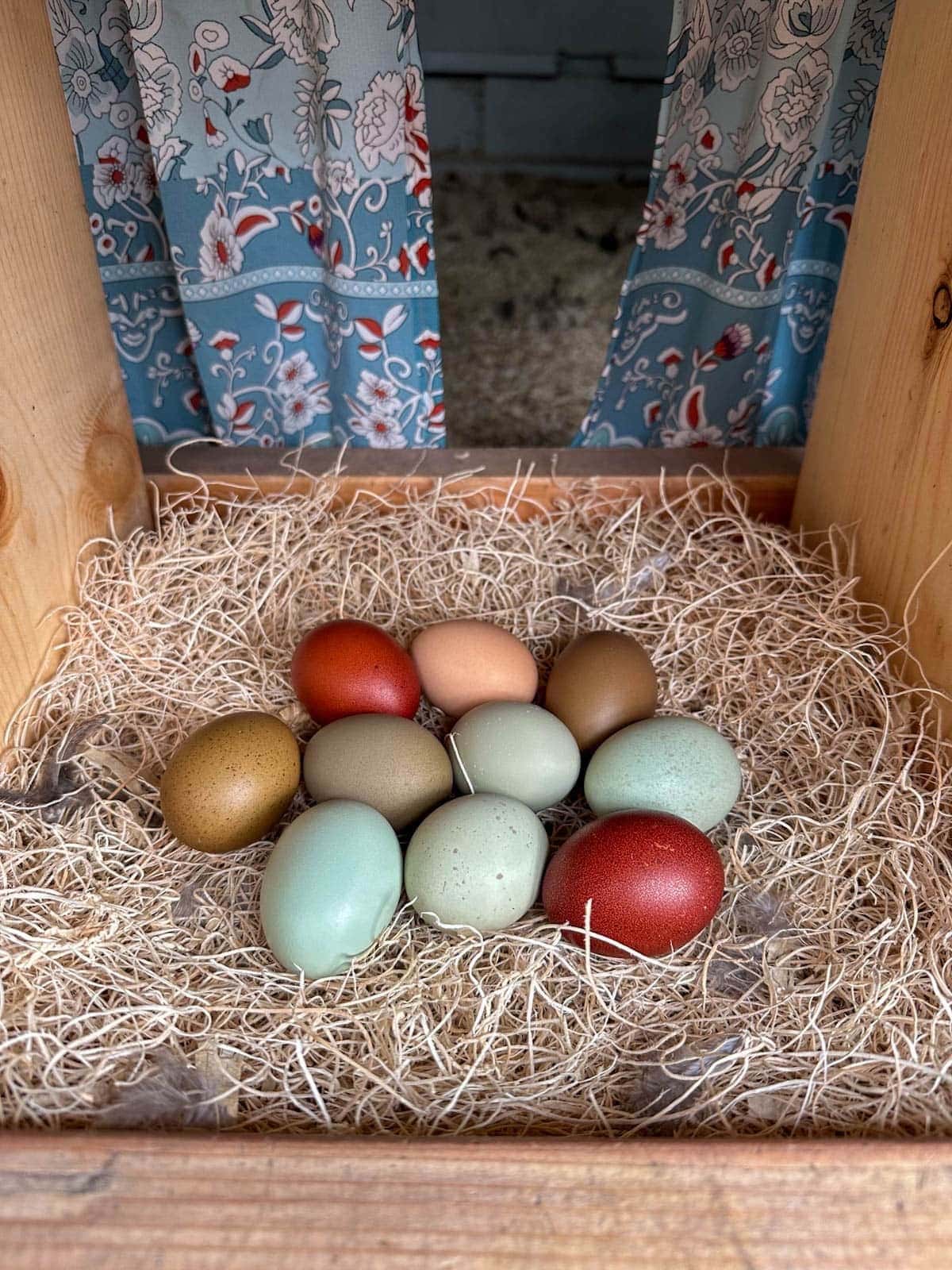

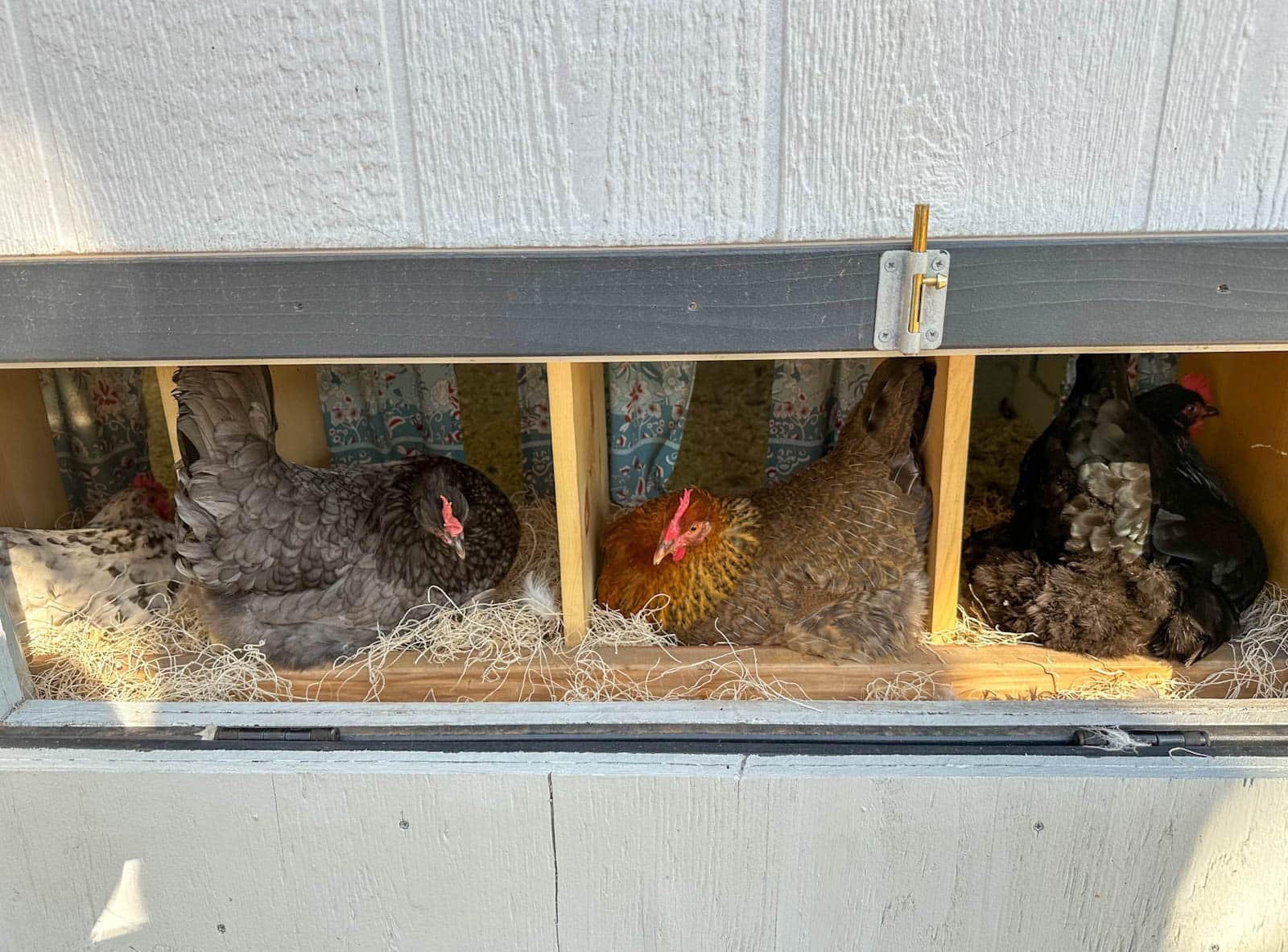
10) Should I let my chickens free range?
There are two key things to consider when it comes to chickens and free ranging: predators and destruction.
Predators
If you live in an urban or suburban setting with little-to-no daytime predators, it may be possible to let your chickens free range with minimal risk. At our old urban homestead, our girls freely roamed the backyard for years without incident, even when we weren’t home! We very rarely saw hawks at that property, and our yard was narrow and well-covered with dense trees and shrubs.
Yet if you have birds of prey around (like we do now at our rural property), it’s only a matter of time… We lost a favorite chicken to a brutal hawk attack recently, so in addition to their enclosed hardware cloth run, we also added poultry netting over their large fenced “day yard” space.
On the other hand, some chicken keepers have a higher tolerance for risk and let their chickens free range regardless, simply accepting that losses will happen.
NOTE: Small, young chickens are far more vulnerable to predators than full grown birds! I don’t recommend letting chickens under 16 to 20 weeks old free range unsupervised, especially if you have hawks or other birds of prey around.

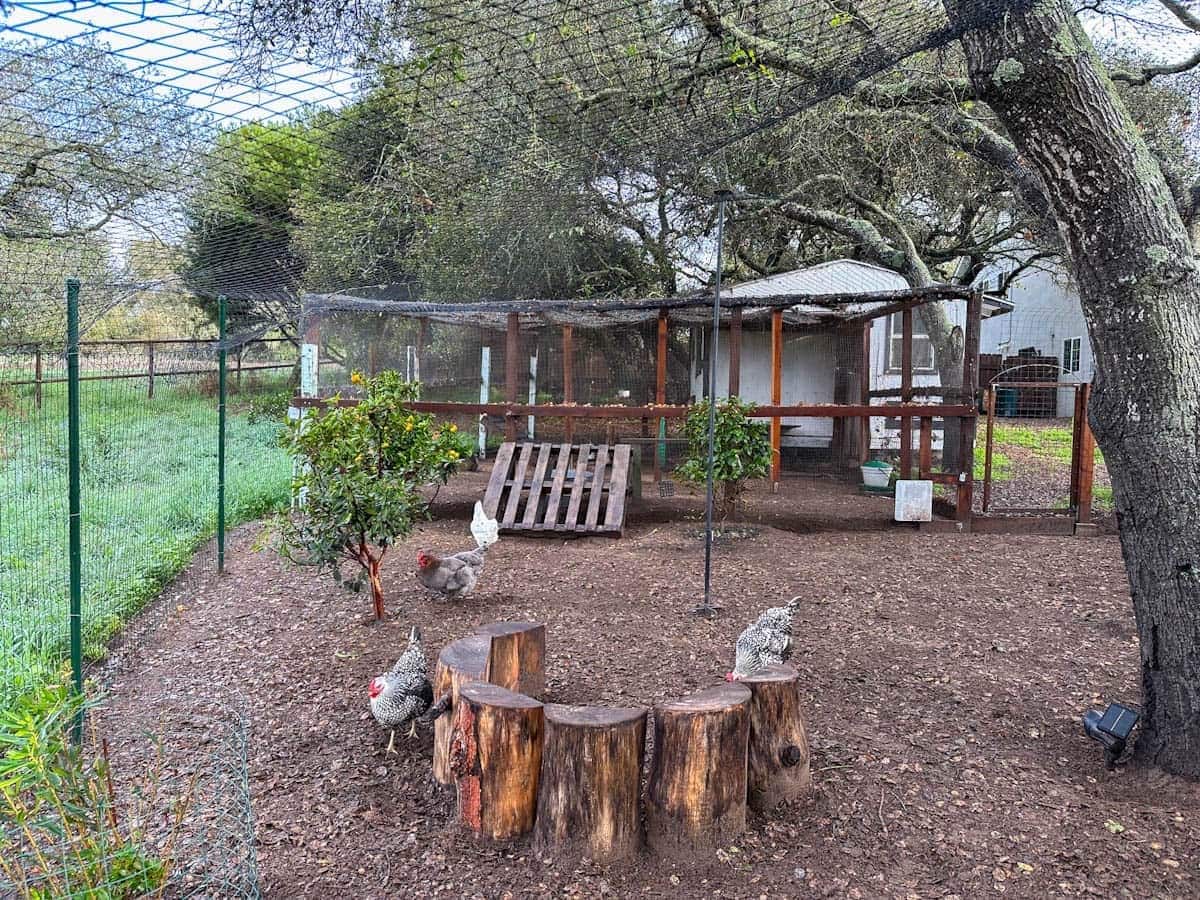
Destruction (and Poop)
Chickens love to dig, scratch, eat plants, and generally make a hot mess of landscaping! They’ll also slowly dig up and destroy lawn areas. So if you have a garden or plants you care about in the same area you plan to allow your backyard chickens to roam, add “plan to protect said garden” to the list. Or, plan to be out there supervising them during free range time.
Also don’t underestimate just how much chickens poop. We’ll talk more about managing manure in the coop and run more below, but if you want to let your chickens free range, be prepared to have poop all over! Even if they have acres to roam, they’ll likely hang out the most right on your back porch, making eye contact through the window as they crap all over your patio furniture.
Despite all this, we still let our chickens free range our old backyard for many years. With time and a little creative thinking, we came up with all sorts of tricks to keep our back yard beautiful, manageable, and useful, for both us and them. For example, by strategically fencing off certain areas like around the back patio, base of trees, or raised garden beds. See photos below!
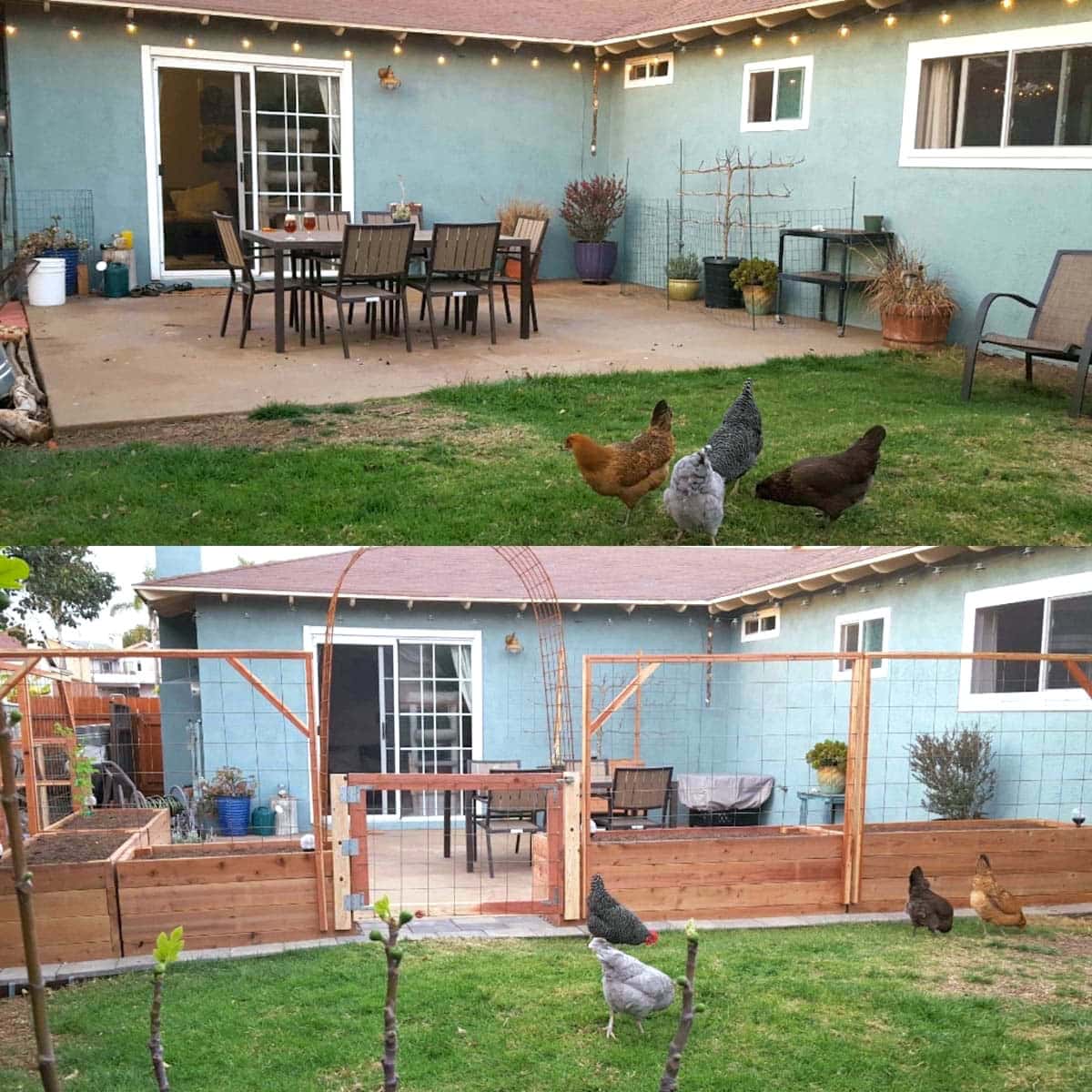
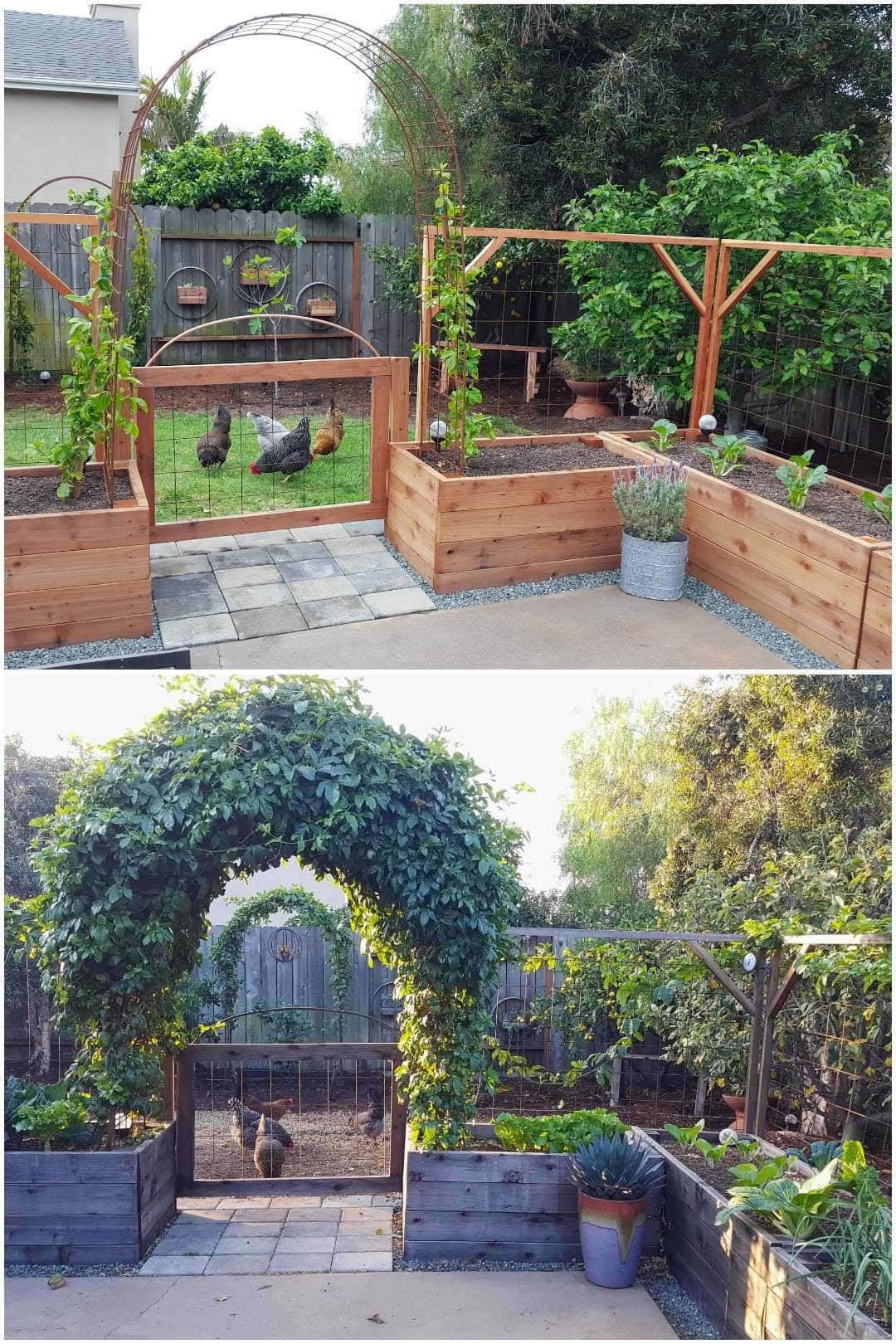
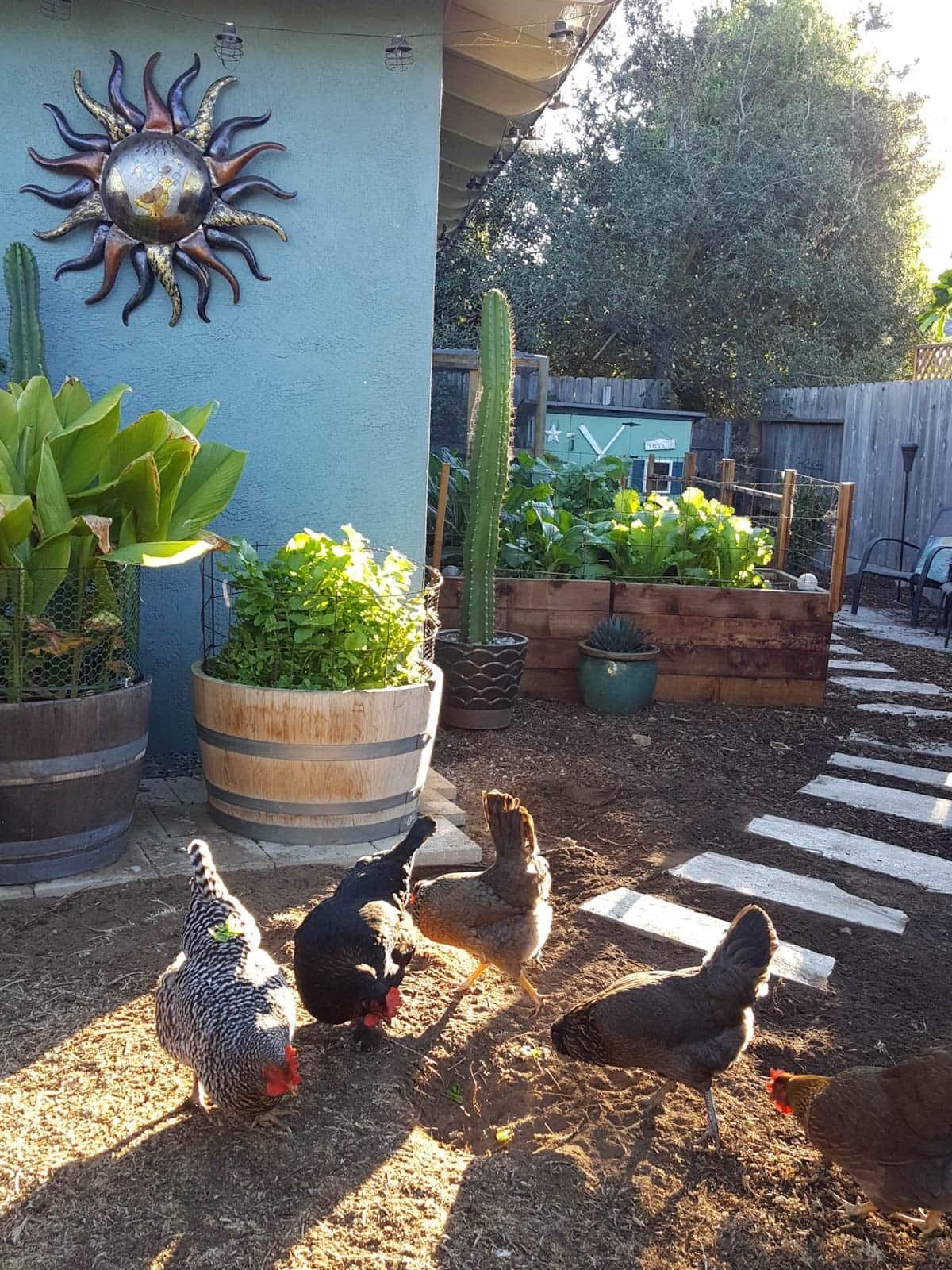
Chunnels
If you have daytime predators or want to limit their access to certain areas of your garden, consider using chicken tunnels (aka “chunnels”) in addition to their run! Chunnels are short chicken-sized tunnels, which create little chicken highways around designated areas of the yard. You can use chunnels to connect two run spaces, or rotate them periodically to different locations.
Other Ranging Considerations
Last but not least, if you are considering free range, do a mental and physical inventory of the space they will have access to. Are there any dangerous materials around, like rat bait or gopher poison? Is the grass treated with pesticides or fertilizers? Are there any sketchy crevices, sharp objects, or places they can get stuck or into trouble? Think of it like toddler-proofing. Chickens are pretty much toddlers – they’ll put just about anything in their beaks they can.

11) Manure Management
Chickens poop about 12 to 15 times per day on average – and I think that’s a conservative estimate! So if you’re thinking of raising backyard chickens, be prepared to deal with a lot of poop. Properly managing manure is essential to keep their space clean and healthy, and to reduce flies, parasites, odors, and pests. You also don’t want to spread treats or food on the ground in an area that has poop.
It’s a good idea to have an easily-cleanable designated pair of “chicken yard” boots, plus a shoe scrubber near their space to wipe your feet as you come and go.
Poop In the Coop
Inside our chicken coop, we made an easily-cleanable “poop board” by covering a thin piece of plywood with sheet vinyl, which is then strategically placed under their roosts. All of their overnight poops fall onto the board (the vast majority of the overall poop in the coop). I can then easily scrape it clean each morning.
In our old reach-in coop, I used a wide paint scraper and dustpan to clean the poop board daily. In our current walk-in coop, I use a long-handled dog poop scraper set. I collect the poop in a nearby bucket with a lid until it’s full enough to take out to the compost. Then we take the poop board out to deep clean once every few months too.
I’ve seen other backyard chicken keepers create “litter trays” full of sand or coffee grounds just below the roosts that are similarly easy to scoop clean. It’s also handy if your roost bars are easy to remove for occasional pressure washing if needed. And if daily cleaning sounds like too much hassle, you could also try the deep litter method.
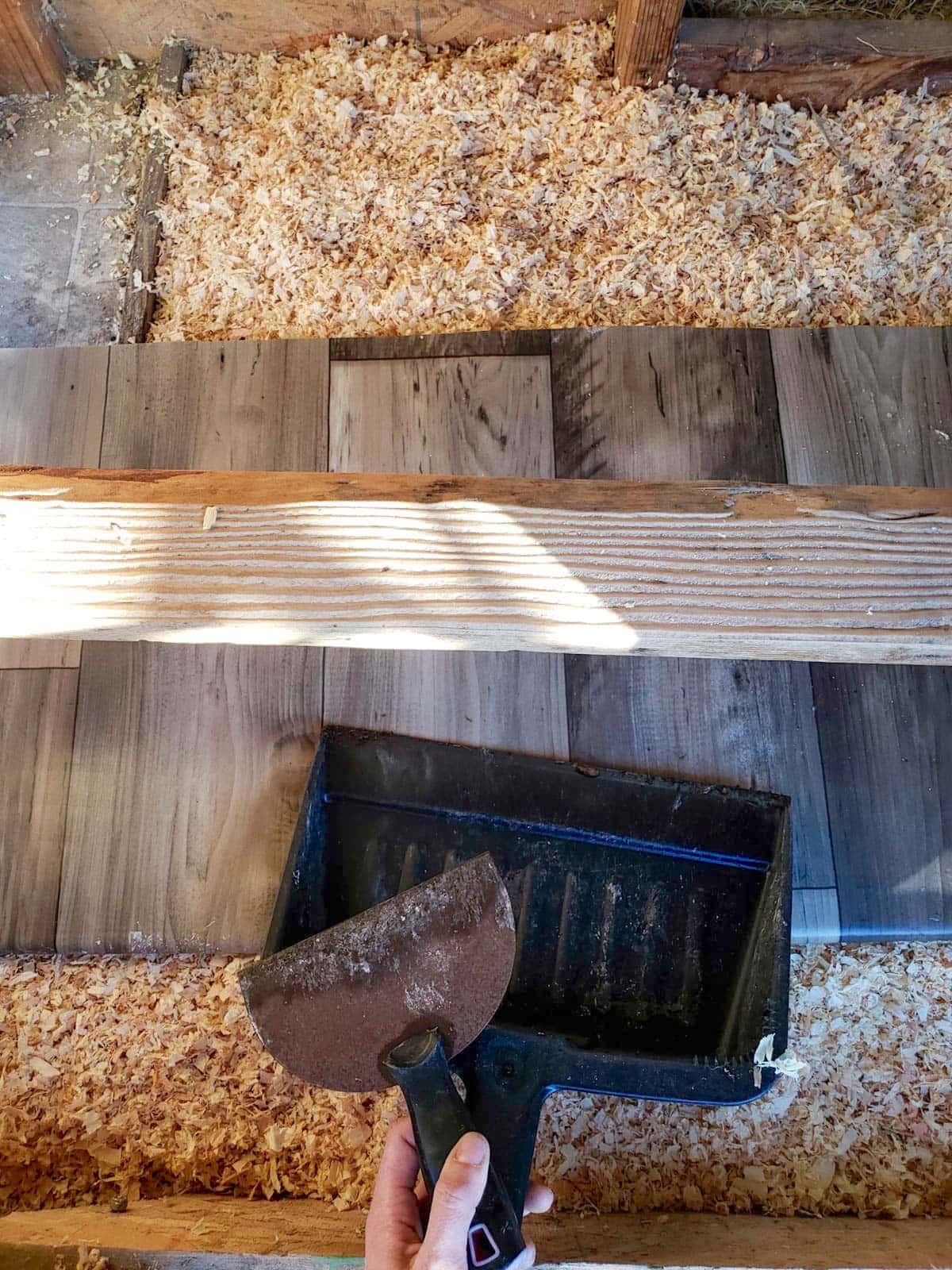
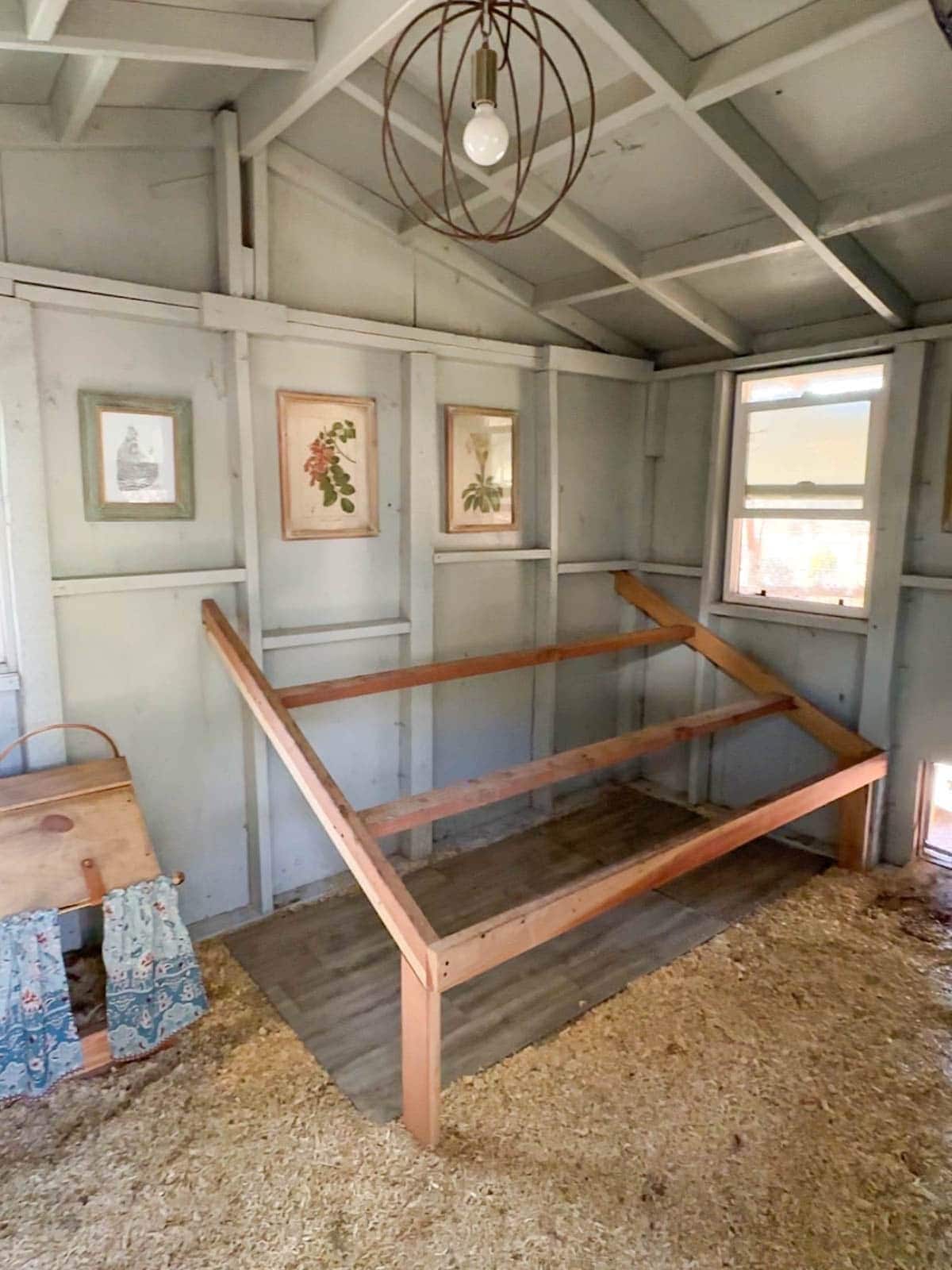
Chicken Run and Yard Poop
Beyond the coop, poop clean up will depend on your property and number of birds. If you have only a handful of backyard chickens and a very large yard for them to free range in, the poop won’t be as noticeable. On the other hand, it will build up quicker in small spaces or with more birds.
Since we currently have 13 chickens, I like to stay on top of things and clean up their run and day yard space every morning with a long-handle dog poop scooper set. In our old backyard (with only four chickens) I picked up poop in the enclosed run about once a week, while most of the poops in the yard simply got churned into the mulch and soil by the chickens – which was awesome fertilizer for the backyard fruit trees!
Using a hose to spray off grass, patios decks or other hard surfaces is also effective.
PRO TIP: Do NOT add fresh chicken manure straight to your garden! It’s too high in nitrogen and can easily burn plants, so it needs to be properly composted first. Letting it sit for a minimum of 6 months is best, if not longer.
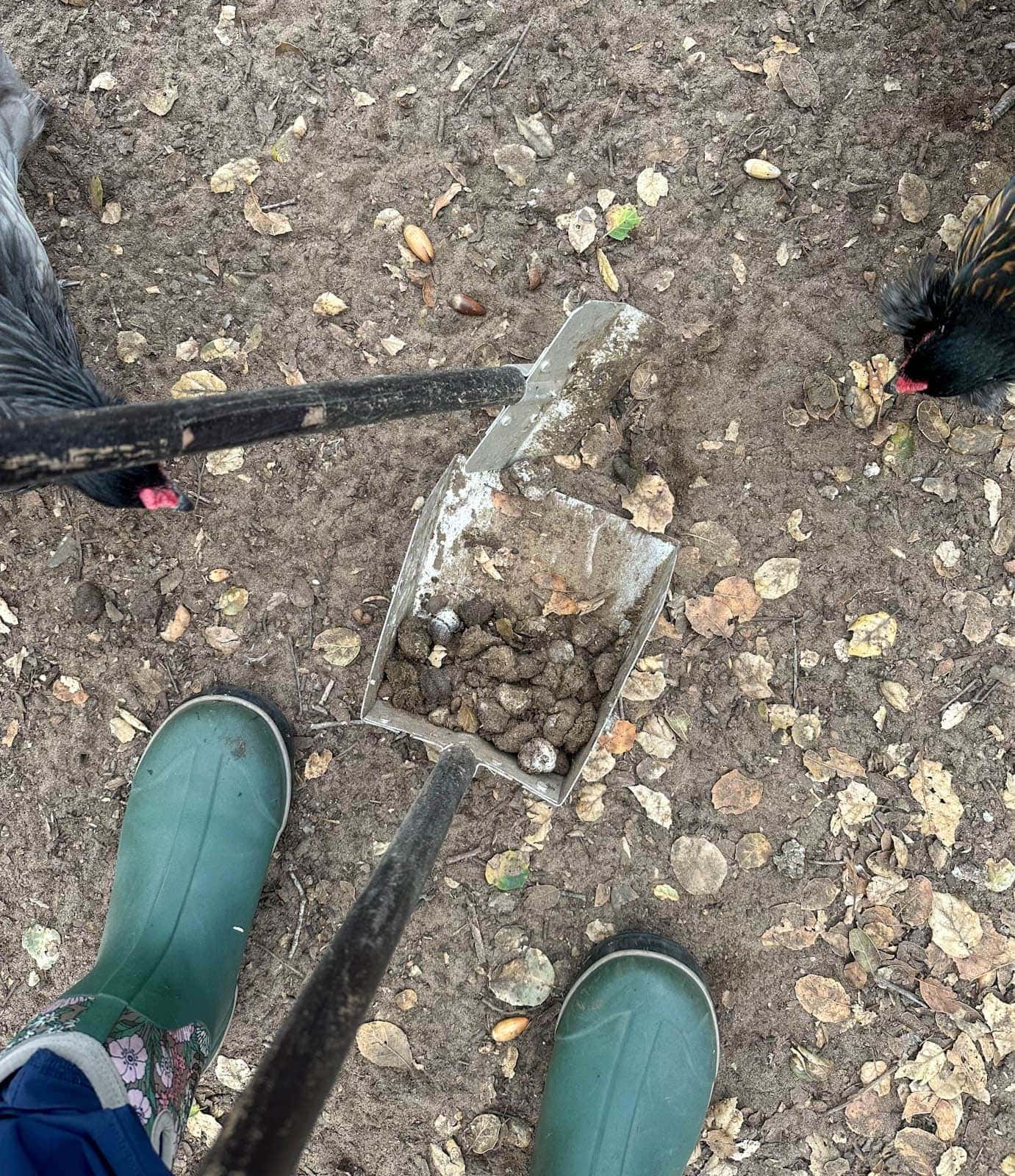
12) Daily Care
Once your flock is established, the daily upkeep can be pretty quick and simple – depending on your set up and situation. Maybe you’ll let them out to range for a bit, refresh their food and water if needed, scoop poop, collect eggs, and always ensure they’re safely tucked into the coop at dark. (An automatic coop door makes this a breeze, explained more in the next section.)
Collecting eggs on a daily basis is important to prevent broken eggs and egg-eating behavior. It also helps prevent them from going broody: when a hen sits on eggs to try to incubate and hatch them (even if they aren’t fertilized). It isn’t ideal because the hen will often stay put, forgoing food and water, thus jeopardizing her health. Learn how to break a broody hen here.
Give them some love and attention! Chickens are curious, energetic, and even affectionate animals. When you can, spend some time with your flock – catching up on gossip over a handful of mealworms. Even a busy day, it’s always good to take a few minutes to observe and make sure everyone is looking healthy and happy. Many chicken illnesses are easy to treat if caught early!

13) Bedtime, Vacations or Late Evenings
Do you have a plan for evenings when you’re away from home after dark, or on vacation? If not, make one! Backyard chickens need to be safely “cooped up” at dark, before any nighttime predators come out.
Thankfully, 99% of chickens will simply put themselves to bed, heading into their coop on their own around dusk as their ability to see rapidly decreases in the dark. Then you can follow behind them and close everything up. Some spunky chickens may try to roost in trees or other naughty places and need re-direction, but not often.
To make sure your flock is safely tucked away each night, I highly recommend investing in an automated chicken coop door. For day-to-day use, late nights, OR vacations – they’re literally a lifesaver! Set it to close awhile after your flock naturally puts themselves to bed and open again in the morning after dawn. Adjust the time as the daylight changes a few times per year.
An auto door helps A LOT but does not eliminate the need for a family member or friend to come check on the chickens if you’re away on vacation for more than a couple days. They can collect eggs, refresh food and water, possibly deal with poop, and do a general welfare check. I would suggest every 3 to 4 days, minimum.

14) Health Issues or Emergencies
There are a number of illnesses and ailments that can affect backyard chickens including crop issues, parasites, bumblefoot, and issues related to laying eggs – such as becoming egg-bound or internal laying – when eggs are not passing normally and can quickly get dangerous.
Many of these issues can be managed with prevention and at-home treatment, but that begs the question: Are you comfortable handling and helping them as needed, such as administering baths or medication? Chances are, even if that sounds weird or scary now, you will be ready to dive in there and help when something goes down! Especially if you raised your chickens from baby chicks. You’ll become accustomed to handling them.
Have a large dog crate, spare bathroom, or other readily-available space that can serve as an emergency chicken hospital when someone needs to be quarantined for TLC or observation. It should be large enough for them to comfortably spend a couple days if needed, with food and water inside. I also like to have a designated tote or tub for chicken baths, Vetericyn poultry spray, and styptic powder on hand to quickly stop bleeding.
For issues that are beyond home-care or your comfort level, do you have a good avian/poultry veterinarian nearby? Or at least a standard vet that will agree to treat chickens? Do a little research ahead of time. It’s better to know now instead of trying to figure it out during an emergency! Trust me. We have a specialty avian vet and a farm vet in our area, plus one cat vet who has agreed to see our chicken in a pinch.

15) Looking to the Future
“What will you do with your chickens once they stop laying?” – people ask me this question all the time. The answer is always the same: they get to live out their lives here, fat and happy, eggs or no eggs.
The average lifespan of a backyard chicken is about 5 to 7 years old, though some chickens can live up to 10 years or longer. However, their egg production will decrease with age. Older hens may only lay one egg a week. Some not at all. Our eldest chicken Hennifer is almost 11 years old, and still lays a couple dozen eggs every spring!
Chances are, between random illness or freak accidents, you’ll probably lose a few chickens before they become old enough to stop laying entirely. Many chicken keepers introduce new chickens to the flock every few years to help create a natural cycle of young, robust layers mixed with older, slower gals.
I hope you aren’t getting backyard chickens JUST for the eggs, and will consider them your quirky companions as well! We don’t eat meat in this house, but even if we did, we wouldn’t eat our pets. I know many, many people who do eat meat, but would never dream of eating their own chickens. Whether you intend to or not, you will form an attachment! They’re too freakin’ cute and have too much personality not to! Like this cute fluffy broad.

With that, your crash course on raising backyard chickens is complete.
If you’re still here, thanks for reading! Your future backyard chickens thank you too. I know that was a lot of information to digest, and you probably still have a lot of questions. But I hope you now feel far more prepared to add backyard chickens to your homestead! Feel free to ask questions in the comments, and please share this post if you found it helpful.
Now, have SO much fun with your new babies! Welcome to the wild and wonderful “crazy chicken person” world.
You may also like:
- The Top 18 Chicken Breeds for Your Backyard Flock
- Raising Baby Chicks 101: The Best Beginner’s Guide
- Top 10 Chicken Coop Supplies That Will Make Your Life Easier
- Feeding Chickens Eggshells or Oyster Shells for Essential Calcium & Health
- 10 Tips on Caring for Chickens in Cold Winter Weather
- 10 Ways to Keep Chickens Cool During Hot Summer Weather or Heat Waves
- When Do Chickens Start Laying Eggs? 5 Tell-Tale Signs It’s Soon!
- Why We Adopted Mini Donkeys: Fun Facts, Our Herd & More






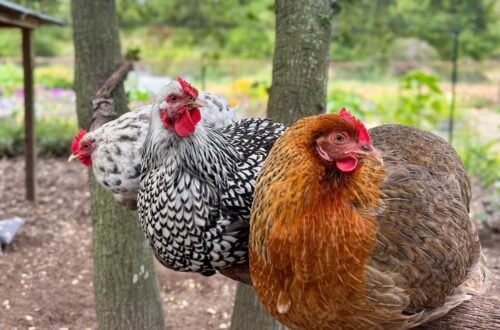

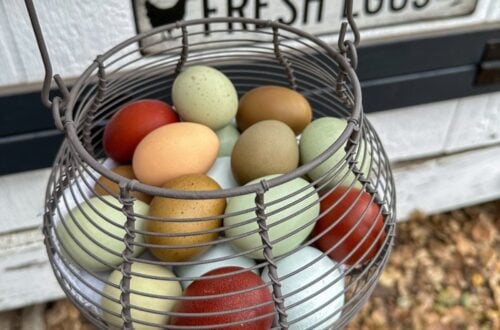
57 Comments
Hollie A.
We decided to do chickens this year, we live outside of a small town, so no restrictions here, but got 10 chicks from a farm supply store and ended up with 1 rooster. We decided to keep him (FOR NOW) and got 2 more pullets of the same age when they were about 6 weeks. My question is, should we be concerned with keeping a rooster? I’ve heard they can get violent with mating and such, I’m not sure I’m ready for that. He’s just now starting to crow and it’s so cute! They are almost 4 months old, so should be getting eggs soon.
Aaron (Mr. DeannaCat)
Hello Hollie, roosters can be much more sweet and tame than what they are known for if they are handled from an early age. We don’t have a rooster but we have seen people use chicken saddles for their hens that keep them from getting too roughed up by the rooster. Good luck!
choi da ga
I was about to toss an old sawhorse left behind by my construction/renovation crew. I just put it outside yesterday to trash it.
Mia
Thank you for your fantastic rundown! It’s given me a lot to think about!
thuoc ga da
I like to have my hens do the work of raising chicks for me… so if one of them goes broody this year, we might consider sneaking a couple of chicks under her. Otherwise, probably not. 20 is plenty for us!
Amanda
Love this post!! So comprehensive. I’d love to know what you keep in your chicken emergency kit. And maybe a post about chicken emergencies you’ve had to handle in the past. Keep writing!!
DeannaCat
Hey! We don’t have too extensive a kit since we live a few minutes away from both a Farm Supply store and our avian vet. It’s even more essential for more rural situations. We have BluKote (watch out! it’s messy!) and Tums (in case they need extra calcium crushed and added to a meal while really sick with egg binding issues). Otherwise I have used human type stuff – hydrogen peroxide and ointments for cuts. Oh yes, we also have had to use Corid for coccidiosis before, and usually keep a bottle of VetRx around for respiratory symptoms. I hope that helps!
Zena
I have just found your fb page and became an instant fan! I’ve spent hours reading and watching your videos. I have so many questions but am going to only ask about what I’m starting with. I started my own worm composter last year. My compost is very wet and I never add water. I do add all our coffee grounds and egg shells and notice that you don’t mention it is ok to compost them. How can I make my compost drier and it is ok to add our egg shells and coffee grounds? Thank you.
DeannaCat
Hey there! Thanks for being here! Coffee grounds and eggshells are on the “yes, feed me this” on the worm bin blog post 🙂 One of the keys is to make sure the coffee grounds aren’t too soggy, and also to add browns/bedding (shredded newspaper, dry leaves, straw, coco coir, etc) when you add food too – too keep everything in good balance. Does that help?
Andrea
Deanna, thank you so much for the comprehensive guide! I was wondering if you have any fly issues? Or does the weekly scoop seem to keep it down? I use free wood chips from Chipdrop in my coop and run, but still have some flies in the fresh manure.
DeannaCat
There are some, but the weekly clean up definitely keeps it far less bothersome!
Tara
Please tell me more about using their shells for calcium. How long and at what temp do you cook the egg shells? Do I need to rinse the shells first or does the baking process burn off any egg residue?
Oh and I was about to toss an old sawhorse left behind by my construction/renovation crew. I just put it outside yesterday to trash it. Now I’ll be moving it out to my chicken run instead! Thanks for the tip! Recycling/repurposing it is much better than tossing it!
DeannaCat
Hi Tara – We don’t rinse them. We keep a container in the refrigerator, like an empty tupperware, and toss eggshells in there as we use them. That way they don’t get funky by being out at room temp. Then once we have a good amount saved up (or when the girls need more) we bake them all spread out on a sheet on 300F for 10 minutes. Crush them into small bits, and store in a jar in the fridge, putting more out for them as needed. Some people don’t bake theirs at all but we like to for a few reasons. One, it will kill off any bacteria that has been allowed to grow. Two, it makes the shells easier to crush, once they’re more dried out and brittle. Three, it does change the flavor and odor of the shells a bit, which I think helps the girls NOT associate the crushed shells with eating regular eggs and eggshells, thus reducing their likelihood to go after their own eggs and starting an egg-eating habit. I hope that helps!
Julie
What do you put on the ground to keep them from digging holes in the mulch??
DeannaCat
We have green coated wire fencing pinned to the ground in select areas like pathways and around the base of raised beds, pinned to the ground under the mulch so that they can’t dig. Other areas, we leave so they can dig and find insects and dirt bath freely
Taylor
Thank you for the great post, Deanna! We have had our flock (13 girls) for a year now and just brought home 6 more babies to add to the mix. We love our girls and absolutely view them as pets. We’ve been super lucky so far and have had minimal issues, save for a couple cases of bumblefoot this past fall (apparently very common in the PNW where it is almost always kind of wet). Your chicken info on insta (and now this post!) have been so helpful and inspiring. We are rebuilding our run and changing up the layout of our coop for them over the next few weeks based on some of what you’ve already shared. Thank you again!!! – Taylor
DeannaCat
Hi Taylor! Oh my gosh you have a lot of birds on your hands! Ha! You must have a decent amount of space then, huh? Or that chicken math hit you really hard. 🙂 Bummer about the bumblefoot! That is one we haven’t had to deal with yet. Thanks for saying hi, and the kind words!
Ali
I LOVE your Instagram and now blog! Thanks for this amazing post! I’ve been learning so much on how to improve and enjoy my own chicken and garden keeping. Could I ask a little more about the coop/run/solar door? Is solar door open during the day when they free range? I guess ultimate question is how do you keep a rodent proof barrier between range space and their food? Early in our experiences we were not as informed as we should have been and initiated a rat problem. It’s better now but I’ve been traumatized ever since. 😳
Thank you!
DeannaCat
Yep! So, the auto door is open to the yard all day. Their food is in their run, pretty protected. Little wild birds do come into the run sometimes and pick at it, but we definitely have never seen any rodents in there. At least around here, rodents only come out into the open at night, and that is once their auto door to the run is all closed up – and the food/water is safely inside there too. Did you have rodents going after their feed at night, or during the day too?
Ali
We had some rats brazen enough to come out in the day. Now we keep food in their secured run with the door closed while they free range. Chickens eat before I let them out in the morning and after I put them in in the evening. It’s just a bunch of back and forth with the doors. I was wondering how everyone else managed this. 🙂
Thanks!
Cassandra Hoer
Loved reading this post! I’ve gone over it several times to make sure I didn’t miss anything. So much awesome knowledge! We bought our first 2 chicks this weekend and 2 more again today! 😁 We’re so smitten 🥰 Chicken math is no joke.